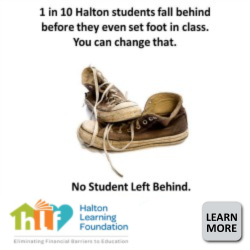 By Pepper Parr By Pepper Parr
October 25th, 2016
BURLINGTON, ON
There is an Ontario Arts Council workshop where valuable guidance on applying to the OAC’s Visual Artists grants program for individual artists is available. They can answer any questions you may have about applying for funding.
 Taking place at Hamilton Artists Inc., 155 James Street North, Hamilton, Ontario. Attendance is free but registration in advance is requested by Wednesday November 2 at 5:00pm. Taking place at Hamilton Artists Inc., 155 James Street North, Hamilton, Ontario. Attendance is free but registration in advance is requested by Wednesday November 2 at 5:00pm.
It is being put on by the Hamilton Arts Council Visual Arts Committee – no reason why someone from Burlington can’t attend.
There is also the November 22 deadline of the Visual Artists: Emerging program is one of the few OAC programs selected as a pilot for a new online grant application system. This session will highlight some of the changes artists will see online, and provide some information on further Visual Arts program updates coming up in 2017.
To learn more about these upcoming changes, visit https://www.arts.on.ca/Page6375.aspx
Attendance is free but registration in advance is requested by Wednesday November 2 at 5:00pm.

 By Pepper Parr By Pepper Parr
October 25, 2016
BURLINGTON, ON
There is a team of four people, Dania Thurman, Michael Kukhta, Lynn Crosby and David Sykes, who rely heavily on parents from Central High School that are putting together the argument for keeping Central High open.
 At a Central high school parents meting they identified some of the issues that needed to be researched. At their most recent strategy – planning meeting, they wrote out a list of topics they need to research to make their case for keeping the high school open.
The topics have been assigned to different attendees at the meeting who volunteered to look at them. The leadership team believes there are many more “out there” who can also help out with the research and who might have additional topics that need to be researched.
Set out below are the topics they have identified. They expect that as the research work progresses some will naturally merge with others. If anyone has any information, articles or research on one of these topics (or any other) to share with the group as a whole, send it along to them at: info@centralstrong.ca If you would like to add your name to one of the topics and be connected with the person doing it please email them so introductions can be made.
What will they do with this research? They want to ensure that their trustees on the PAR Committee have it, so they can present it and use it at the committee meetings and use it in letters to the committee during the public input sessions.
People can use any of this research to present at the 5-minute “public delegation” sessions to the trustees that are scheduled for April 18, 2017 and any other meetings where delegations are allowed. Their objective is to convince trustees that closing Central is not the best option.
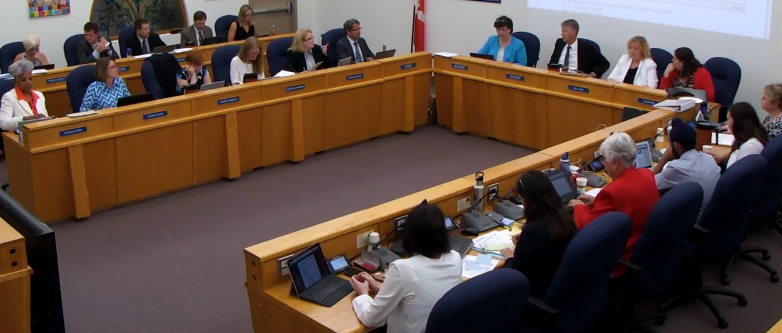 The trustees will make the final decision next May. Parents are going to have to work with their trustees and convince them of the merits of the arguments they put forward. “It is important that Trustees receive letters on any of these topics or other factors you feel will make an impact. Simply explaining your own personal thoughts on why Central is so important to you and your family is also very important, ” suggested the team leaders.
The Program Accommodation Review (PAR) process begins officially on December 1 with an orientation session that will take place in each high school.
Tuesday, November 1, 2016 Robert Bateman HS 6:00 pm – 7:00 pm
Tuesday, November 1, 2016 Nelson HS 7:30 pm – 8:00 pm
Thursday, November 3, 2016 Aldershot HS 6:00 pm – 7:00 pm
Thursday, November 3, 2016 Burlington Central HS 7:30 pm – 8:00 pm
Monday, November 14, 2016 Lester B. Pearson HS 6:00 pm – 7:00 pm
Monday, November 14, 2016 M.M. Robinson HS 7:30 pm – 8:00 pm
Tuesday, November 15, 2016 Dr. Frank J. Hayden SS 6:00 pm – 7:00 pm
These is just orientation sessions – there will be no Q&A. Just the facts as the HDSB sees it all.
The first public meeting is on December 8.
The PAR Committee (with two representatives) will work through January, February and March.
A second public meeting will be held on March 2.
The Director will then prepare a report with all of the compiled feedback.
April 18 will be another public delegation night.
The BCHS parent group wants to see a big turnout of supporters at all of the public sessions. The final report will be presented to the Board of Trustees on May 3 and they will vote on it on May 17.
The BCHS goal is to show the Board why their recommended option is the wrong one.
Here are the topics the BCHS parents are going to research. The list may expand and some of the topics may merge.
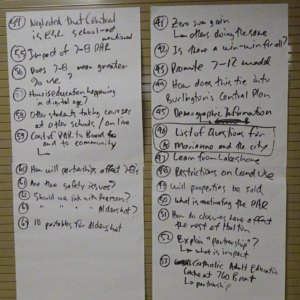 Some of the issues to be looked into that came out of a BCHS parent meeting. – Accessibility issues – Cheryl
– Partnerships – Shawna
– School Profiles (SIPs) – Maureen – this is a vital one and Maureen will likely need group input with this
– Transportation/bussing – Kevin
– Benefits of small schools – Heather
– City Strategic plan – Marianne
– Urban Growth Centre – Marianne
– Data collection/missing data/incorrect data – Mike Matich
– History of BCHS – Deborah and Lynn
– Market Share of Students – Deborah and Lynn
– Impact on 7/8 Students – Theresa and Dania
– Number of Seats Available vs. used – data – Stacey
– Socioeconomic Impact – Dania and Paul
– Alternate Options – Emil
– Fundraising/Alumni Support (compared to other schools) – Theresa and Laura
– The Process – Josie, Allison
– Appeal Process – Mike, Allison
– Ministry Funding Formula – Josie, Lynn and Deborah
– Special Programs at BCHS – Courtney and Karen
– Projected Numbers/Data – Andrew
– Costs/Capital – Phil and Todd
– Challenging Board Assumptions – Josie (other research on other topics will feed into this)
Other topics that should be considered as recommended by Terry Ruf and others include:
– Catholic Board PAR/LTAP interaction
– Strengths of Grade 7-12 schools
– Advantages of unified cohorts coming from feeder schools
There were 19 options identified. The Board staff chose to go forward with Option 19 however the PARC is free to use any other option or a mix of several options. The options were possibilities as the board staff saw things.
Option 13 makes a statement about unified cohorts, acknowledging this advantage, yet Option 19 will see split cohorts coming out of Central Public and Tom Thompson (depending what happens to the 7/8) as well as FI students from Pineland
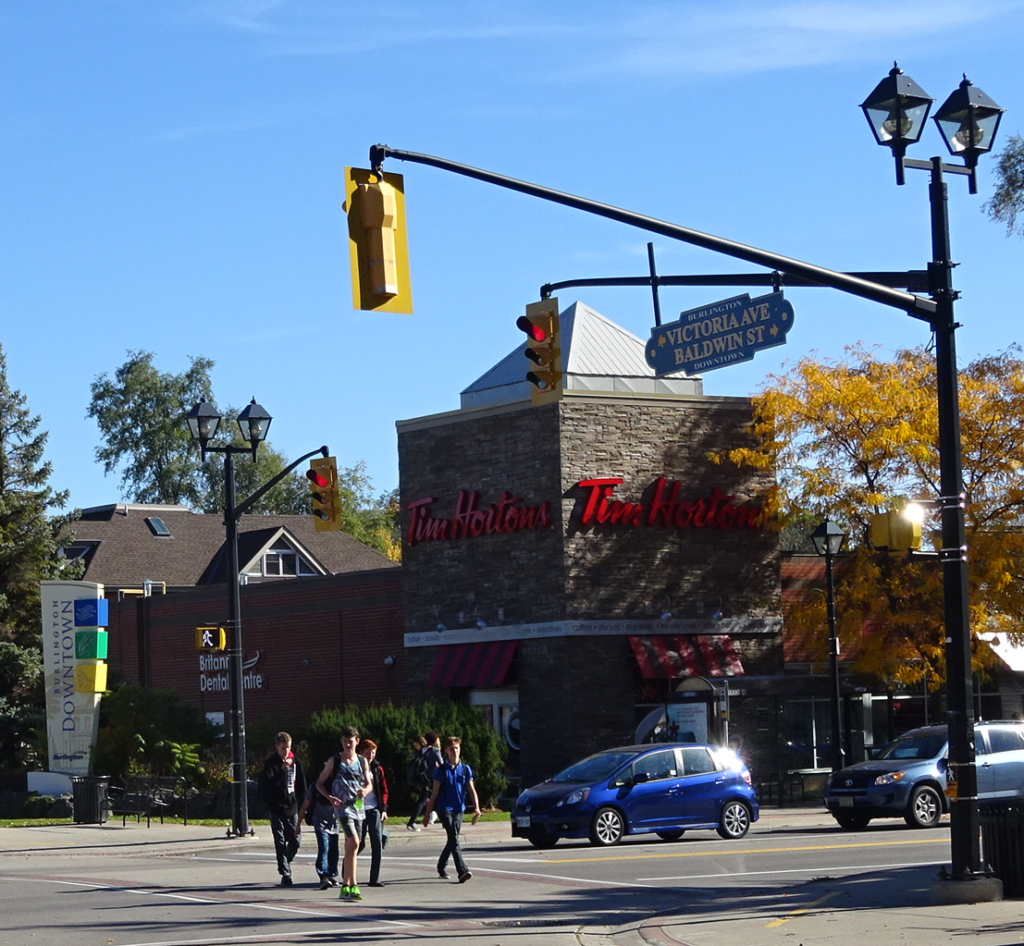 A Tim Hortons is considered part of a “complete community” Should the high school actually close – the revenue stream at this Tim Hortons is going to take a big hit. – Community School culture – Terry Ruf sees this in Central but is not sure all the high schools has what Central has. Central is suffering from some tunnel vision on this one. Pearson has a culture every bit as rich as Central.
– Central does have a unique configuration its Jk to graduation is unique. Does it limit the horizons of a student who does every day of their public school education in one location?
There is a lot of work to be done – and the parents at Central are well into it.
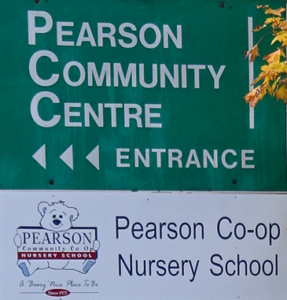 The parents at Pearson have begun their work – they do have some catching up to do and they do have a very unique situation to deal with: – The Co-op nursery that has been part of that school for more than 40 years which the Gazette will report on. The parents at Pearson have begun their work – they do have some catching up to do and they do have a very unique situation to deal with: – The Co-op nursery that has been part of that school for more than 40 years which the Gazette will report on.

 By Pepper Parr By Pepper Parr
October 24, 2016
BURLINGTON, ON
The meetings to explain the Program Accommodation Review to patents will take place on the dates and at the high schools set out below.
Date School Time
Tuesday, November 1, 2016 Robert Bateman HS 6:00 pm – 7:00 pm
Tuesday, November 1, 2016 Nelson HS 7:30 pm – 8:00 pm
Thursday, November 3, 2016 Aldershot HS 6:00 pm – 7:00 pm
Thursday, November 3, 2016 Burlington Central HS 7:30 pm – 8:00 pm
Monday, November 14, 2016 Lester B. Pearson HS 6:00 pm – 7:00 pm
Monday, November 14, 2016 M.M. Robinson HS 7:30 pm – 8:00 pm
Tuesday, November 15, 2016 Dr. Frank J. Hayden SS 6:00 pm – 7:00 pm
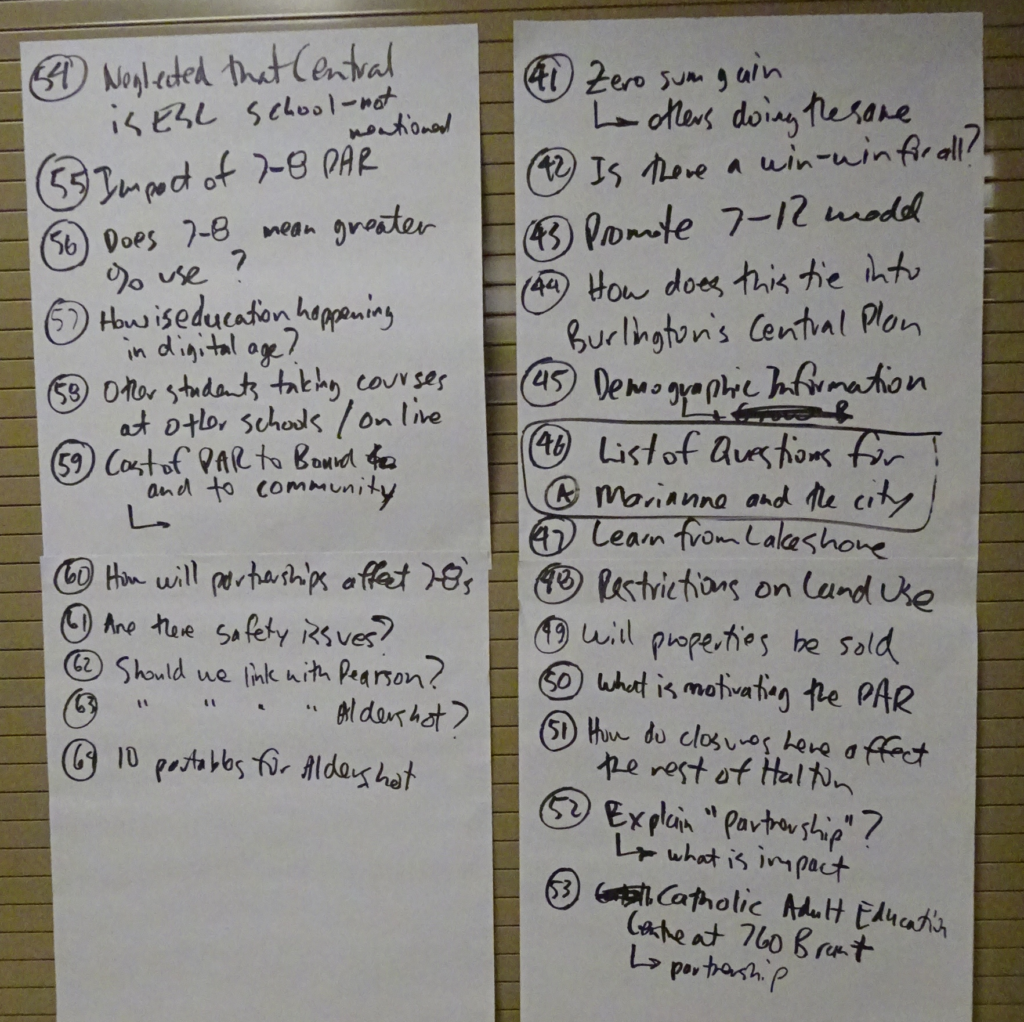 There is a lot of work to be done on the part of parents. Central High school parents set out the tasks as they saw them. Once parents have an understanding of the process the Program Accommodation Review Committee (PARC) gets set up.
The members of the PARC (there will be just the one committee) will be:
A Trustee as an ad hoc member, and Superintendent, both from an area not under study;
From each affected school:
the school Principal or designate (resource only)
two parents/guardians from each school, one of whom will be nominated by the School Council Chair; the other will be selected by the Superintendent(s) through the submission by parents of an expression of interest.
The Superintendent will review all parent representation and endeavor to ensure that all affected geographic areas and programs are represented.
A municipal Councillor will be invited to the committee once the committee is formed.
This is not going to be a small committee”
1 trustee
1 Superintendent
14 parents
7 principals
1 municipal Councillor
Our count is 24 people.
Timeline for the complete process:
PAR Initiated
October 19, 2016 (Done)
J.W. Singleton Education Centre
2050 Guelph Line
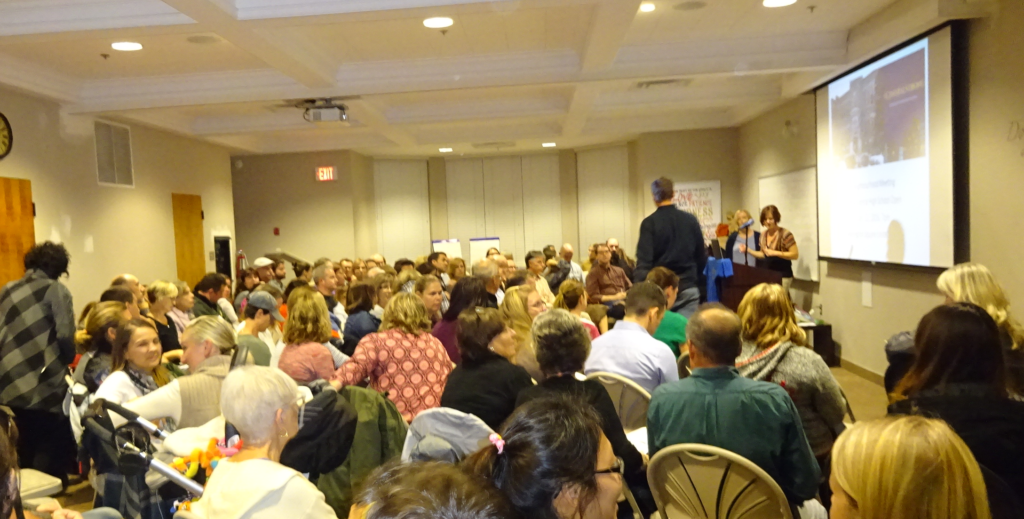 Expect to see rooms full of parents for the next number of months. This was the first parents meeting for Central High school parents. Formation and orientation of Program and Accommodation Review Committee (PARC)
December 1, 2016
TBD
Public Meeting #1
December 8, 2016
TBD
PARC Working Meeting #1
January 26, 2017
TBD
PARC Working Meeting #2
February 2, 2017
TBD
PARC Working Meeting #3
February 9, 2017
TBD
Public Meeting #2
March 2, 2017
TBD
PARC Working Meeting #4
March 23, 2017
TBD
Director’s Report to Committee of the Whole
March 29, 2017
J.W. Singleton Education Centre
2050 Guelph Line
Public Delegation Night
April 18, 2017
J.W. Singleton Education Centre
2050 Guelph Line
Presentation of Report to Board of Trustees for Decision
May 17, 2017
J.W. Singleton Education Centre
2050 Guelph Line
There is a lot of work to be done – and a considerable amount of disruption throughout the high school system in Burlington.
What the parents need to understand is that it is the trustees they elect who will make a final decision not the bureaucrats. Work with your elected officials.

 By Pepper Parr By Pepper Parr
October 22, 2016
BURLINGTON, ON
The following is not something you are likely to see coming out of Burlington’s city council.
 Halton District School Board trustees. The Halton District School Board passed the following:
With the unanimous approval of Motion M16-0121 on June 15, 2016, the Halton District School Board authorized the posting of the Board’s Trustee Code of Conduct Policy on the Board’s website for public input, for a period of no less than 25 days.
Any feedback received was to return to the Board at the second meeting in September 2016.
RECOMMENDATION:
Be it resolved that Halton District School Board approve the “Trustee Code of Conduct
” policy, as revised, and appended to Report 16127.
Burlington’s city council has been avoiding the creation of and agreement on a Code of Conduct for the members of Council – not the sign of a healthy organization.
 Burlington’s city council One has to wonder why such a state exists.
The task was left with the City Manager to get something worked out. Don’t hold your breath waiting for that to happen.
This council does not want a Code of Conduct and the city manager isn’t going to work all that hard to bring anything to the table.

 By Pepper Parr By Pepper Parr
October 21, 2016
BURLINGTON, ON
For the parents at Lester B. Pearson high school the thought of their school closing is a tough one.
Many parents wanted their children to attend a small school and moved into the neighbourhood for just that reason.
Some talk about actually moving out of the community or “we will send our kids to St. John”, which is the local Catholic school.
Another parents, who asked not to be identified said she did not want her kids “going to the pharmacy”, which was code for a school with a drug problem.
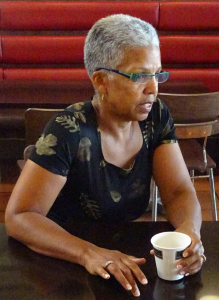 Trustee Richelle Papin During the Board of Education discussion about Lester B. Pearson (LBP) trustee Richelle Papin talked about the Nursery Program in the school that has been in place for more than forty years that has become a model and a training ground for students from Mohawk who expect to work in the child care field.
The Halton District School Board is acutely aware that they face a serious situation where, as Director of Education Stuart Miller put it – “Students will begin voting with their feet and we will lose even more students”.
All the feelings and concerns don’t change the facts – Burlington has too much high school capacity. There are 1800 high school student seats that the Board can’t fill.
Yes, there is some intensification taking place but condominiums are being built and they tend not to house families with several children. Add to that – the population growth has been north of the QEW and the high school capacity is south of the QEW.
The Board of Education staff set out 19 possible options – and recommended what is referred to as option 19 – which proposes that:
• Close Lester B. Pearson HS, and redirect students to M.M. Robinson HS
• Close Burlington Central HS and redirect students to Aldershot HS and Nelson HS
• Change Dr. Frank J. Hayden SS boundary and programming.
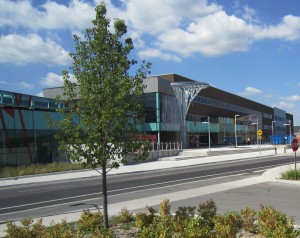 Hayden High school, Burlington’s newest already has portable classrooms and spotty WiFi service as well. This recommendation is not a final decision of the Board of Trustees, but a starting point for consultation.
Stuart Miller, Director of Education said: “I want to stress that the recommended option is the starting point for the Program Accommodation Review (PAR) process.” “With feedback from the public, and the research and work of the PAR committee, a different solution could arise as a result of this process.”
Initial information sessions will be held to provide communities with further information about the PAR process and rationale for why the Board is undertaking a PAR for Burlington secondary schools. These sessions will be ‘information only’. There will be no question and answer opportunity at these initial sessions.
There is a massive amount of data and detail the public will need to think through the alternatives.
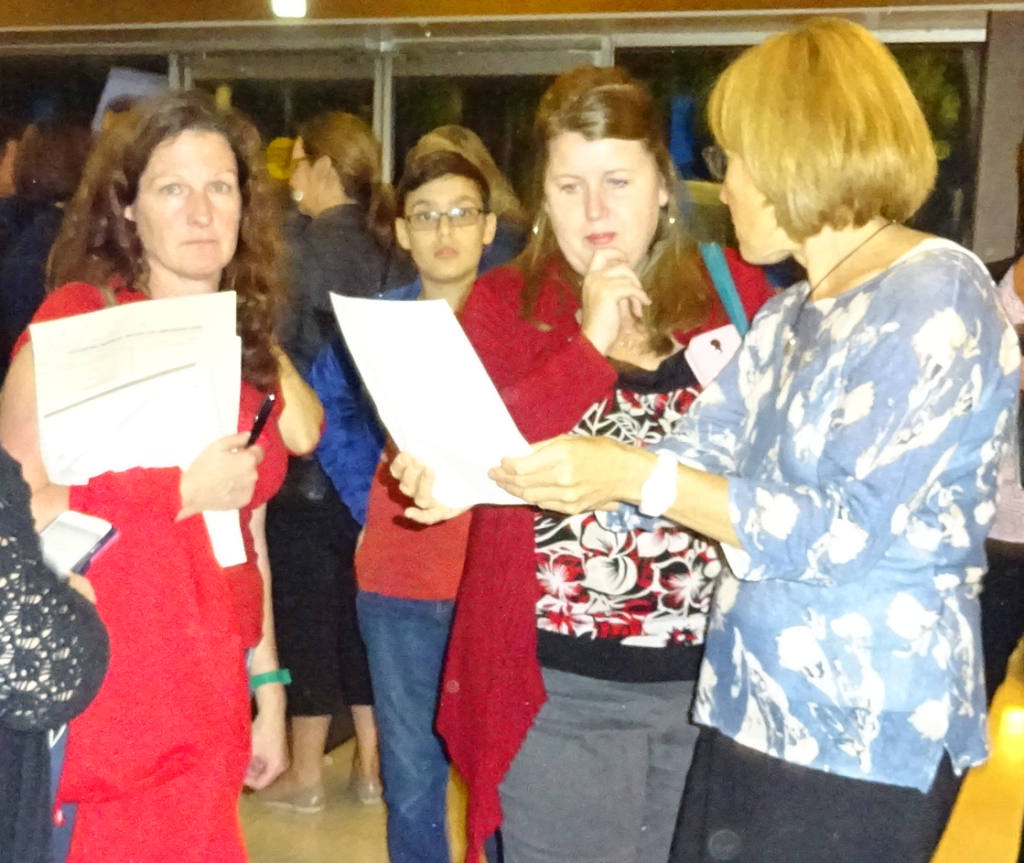 Parents looking over the agenda for a Board of Education meeting. Parents are now in the process of setting up what will be called PARC (Program Accommodation Review Committees) that will work through everything and give the Board of Trustees their recommendations.
It is the Board of Trustees that will make the final decision – however, whatever decision they make has to comply with provincial government guidelines and the cold hard fact is that – there are too many spaces south of the QEW and not enough north of the QEW.
The Hayden High school that hasn’t been open for three years already has portables set up – and worse – the WiFI service is “spotty”.
 The people you elected as trustees are going to have to work with parents groups to come up with solutions that satisfy as many people as possible. It is going to be a busy year for everyone. The really positive upside is that the parents who have surfaced and are facing the challenge are a bright, energetic bunch of people –they are going to come forward with a solution.
It is the parents that are going to make the difference.

 By Pepper Parr By Pepper Parr
October 20th, 2016
BURLINGTON, ON
There will be a Program Accommodation Review (PAC) – and it is going to keep the parents hoping.
Board of Education trustees voted last night 10 – 1 to form Program Accommodation Review Committees.
The possible closure of both Burlington Central High school and Lester B. Pearson high school are now distinct possibilities.
There is a tremendous amount of work to get done and the learning curve is going to be very steep for the parents.
A Program Accommodation Review is something a board of education has to do when the enrollment in a school falls below 65%.
 Central High school could handle an additional 275 students – but they just don’t live in the community.  Lester B. Pearson is a small school to start with and enrollment is projected to decline. The recommendation the Board put on the table was to look at closing both Lester B. Pearson and Burlington Central High school.
Central High is a large school with a very strong connection to their community – they hit the ground running and have made strong arguments for not even holding a Program Accommodation review at this time.
The trustees didn’t see it that way and voted to take the next step which is to form a Program Accommodation Review Committee (PARC). (Note the school board people love acronyms – get used to them.)
The task now is to create the PARC’s. Burlington Central is well prepared for this next step.
Lester B. Pearson (LBP), a much smaller high school and it doesn’t have the depth as a community school that Central has. We will return to the LBP situation.
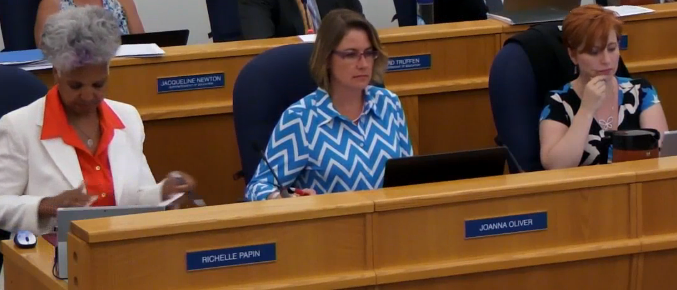 Trustees Papin, Oliver and Grebenc The Board of Trustees is responsible for deciding the most appropriate pupil accommodation arrangements for the delivery of its elementary and secondary programs. Decisions that are made by the Board of Trustees are in the context of carrying out its primary responsibilities of fostering student achievement and well-being, and ensuring effective stewardship of school board resources. The Board of Trustees may consider undertaking pupil accommodation reviews that may lead to school consolidations and closures in order to address declining and shifting student enrollment.
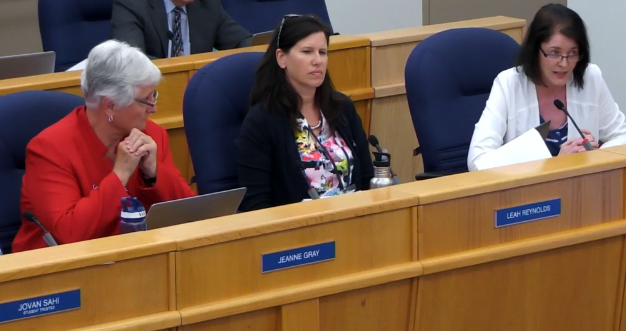 Trustees Sams, Reynolds and Collard. The PARC process has been revised and this is the first time the Halton Board has had to work under the new rules which shorten the amount of time to go through that process.
Here are the steps that are going to be taken:
● Director’s Preliminary Report to the Board of Trustees; DONE
● Preparation of the School Information Profile(s); these are ready to now be turned over to the PARC that is to be formed.
Each high school will have its own PARC
● Board of Trustee’s approval to undertake a Program and Accommodation review process; They did that on October 19th.
● Communication with all stakeholders about the process, opportunities for involvement, and identifying outcomes; The Board staff are going to have their work cut out for them on this level.
● Establishing the Program and Accommodation Review Committee; The jockeying for the spaces on this committee is going to be interesting to watch.
● Consultation with Local Municipal Governments/Community Partners;
● Public Meetings;
● Final Staff Report, including a Community Consultation section;
● Public Delegations to the Board of Trustees;
● Decision by the Board of Trustees; and,
● Implementation and Transition Planning.
A PARC will be formed following the consideration by the Board of Trustees of the Director’s Preliminary Report.
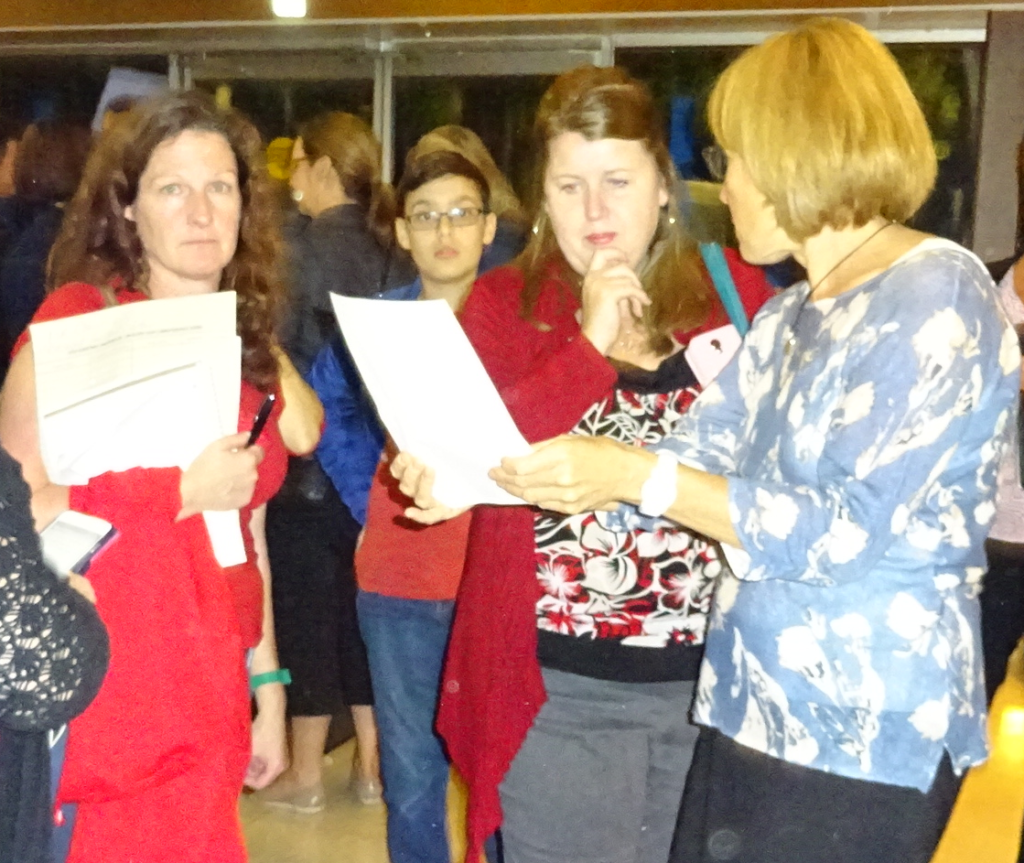 Parents getting the agenda explained to them by the Board o Education communications manager. The PARC will consist of the following persons:
A Trustee as an ad hoc member, and Superintendent, both from an area not under study;
From each affected school:
the school Principal or designate (resource only)
two parents/guardians from each school, one of whom will be nominated by the School Council Chair; the other will be selected by the Superintendent(s) through the submission by parents of an expression of interest. The Superintendent will review all parent representations and endeavor to ensure that all affected geographic areas and programs are represented.
All Trustees are invited to attend PARC working meetings to observe the proceedings.
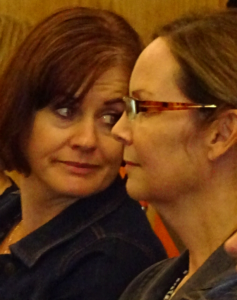 Dania Thurman on the left – one of the more active parents at Central High school. The PARC is to be created within five business days of the motion to form the PARC was passed – which happened yesterday. Things begin to move very quickly at this point – and it is going to be difficult for the parents at Lester B. Pearson to keep up.
Once the PARC is constituted, it will invite a municipal Councillor or delegate to join the Committee. The Committee will be deemed to be properly constituted whether or not all of the listed members are willing and able to participate.
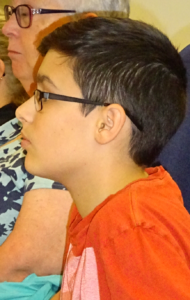 Matthew DiSouza – a Lester B. Pearson student The Board will invite PARC members from the school(s) under review to an orientation session that will describe the mandate, roles and responsibilities, and procedures of the PARC.
That is what the community is going to immerse themselves in – the people selected for the PARC is important – getting the right people is important.
How did we get to this point? Well enrollment numbers were the first indicator that a change was needed. Burlington has seven high schools, Oakville has six. And Oakville has a larger high school population than Burlington.
Director of Education Stuart Miller explained that the preferred size of a high school is 1200 students. He added using that number Burlington has one and a half too many high schools.
That is the lens the board of education bureaucrat use – they have to look at the numbers – the province requires that they do just that.
However, it is the parents that are at the top of the food chain. It is their money that pays for everything and it is the education of their children that is at issue.
It is now up to the parents to come up with the ideas that will resolve the problem on the table.
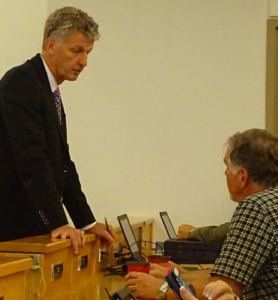 Director of Education Stuart Miller getting a briefing. Miller said a number of times that the option put on the table is rarely if ever the option that gets chosen. Which is fine but in order to be able to come up with the best option parents need to ensure that they do not lose control of the process.

 By Pepper Parr By Pepper Parr
October 20th, 2016
BURLINGTON, ON
It is just under a month away but registration for this event is going to fill up very quickly – you will want to register now if you’d like to attend.
This struck the Gazette as one of the more interesting ways to promote the history of the city – and if anything is history in Burlington it is the Freeman Station.
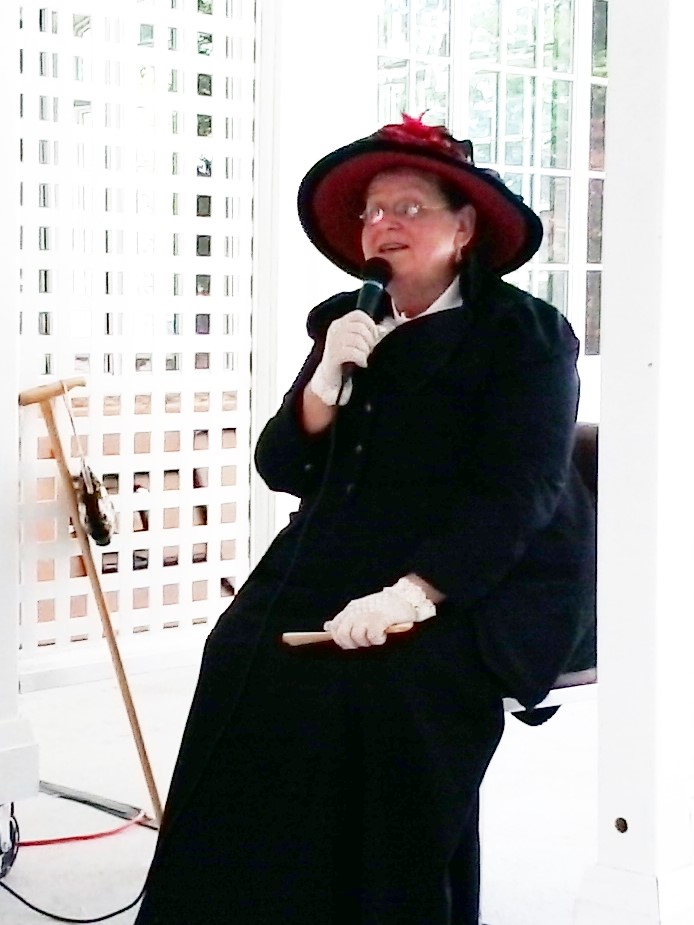 Pauline Grondin – the year is 1920 and she is at the Burlington Junction station in Freeman. On Saturday, November 19th, well-known professional storyteller Pauline Grondin will again work her magic as she relates, first-person, her story of life around Freeman Station.
The year is 1920, and the Burlington Junction Station in Freeman is a vibrant hub of community comings and goings.
Pauline will bring history to life for us as she relates what’s happening around the village. (A bit of gossip here and there?)
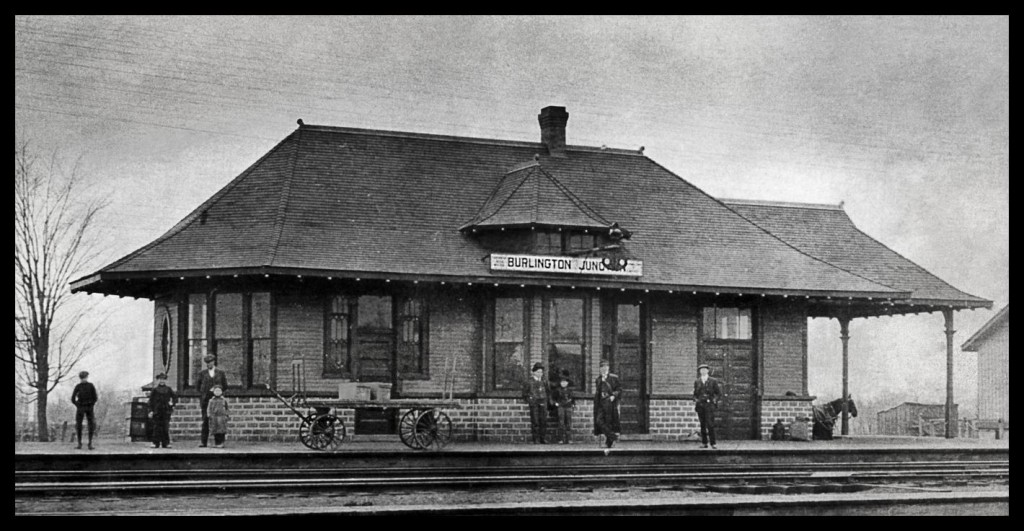 Waiting for the train. The Friends of Freeman Station invite you to join them at the Burlington Seniors’ Centre for “Breakfast at the Bistro,” beginning at 8:30 AM for a delicious meal followed by Pauline’s enchanting presentation.
Reservations are required, seating is limited, breakfast is only $ 6.18 per person, tax included, it’s all for a great cause, and a good time will be had by all. Nostalgia guaranteed, tears optional.
Book early! Registration is required. Limited seating, and typically sells out well in advance.
To register, log onto: https://secure.burlington.ca/recexpress/Activities/ActivitiesAdvSearch.asp
and enter the code “345506” in the TTR Barcode Search field to pull up Breakfast at the Bistro – Pauline Grondin – 345506

 By Pepper Parr By Pepper Parr
October 18th, 2016
BURLINGTON, ON
You knew before the meeting was over that this was a group of parents who were going to think through the situation they faced very thoroughly and present a case for keeping the community school.
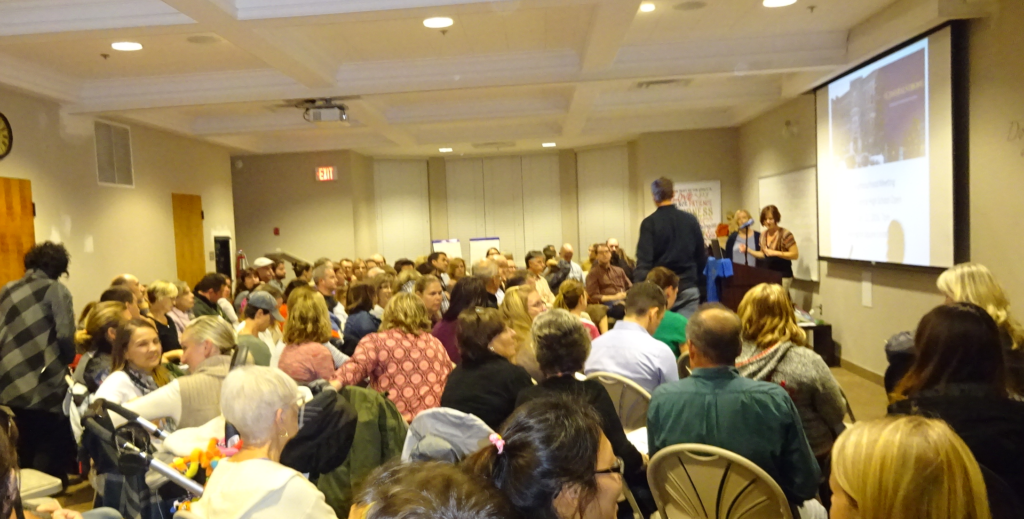 They packed the room. There were well over 80 people (some set the number at close to 100) packed into a room at Wellington Square United Church to figure out what they wanted to do about the Halton District school Board decision to hold a PAR.
A PAR is a Program Accommodation Review which is a look that the board has to take when the amount of available space in a school falls below 65%
A PAR – to address enrollment, empty/overfull space and programs offered – is needed for Burlington secondary schools claim the parent group – but the conditions needed to hold a PAR are not yet in place.
In its report Board of Education staff found a number of school that were below or very very close to that 65% number and they produced a report that set out 19 option. The options were related to various schools in Burlington.
 There are just too many empty seats at Central High.  The utilization percentages are good – bu the sea available are in the wrong schools.  The parents group covered everything – and then some. The parents did their homework – the looked at the facts and they came to the conclusion that while there might be a need for a PAR – this was not the time to proceed.
The Board for its part produced an exhaustive report – we are talking inches thick here and it takes time to go through the details and then measure them against what the parents know and experience.
The letter was signed off on by Michael Kukhta and Dania Thurman who were speaking on behalf of the Burlington Central Strong Community Group).
Michael had run for school board trustee before Dania is new to the game but keep an eye on this woman. She is a force to be reckoned with.
In a letter to the school board trustees this group of parents from Burlington central high school said:
At the Halton District Board of Education (HDSB) Board of Trustees meeting on 19 October 2016, you will be deciding on a motion to approve beginning the Program Accommodation Review (PAR) process.
In this letter, we will outline why we urge you delay the start of the process by tabling the motion until numerous issues are addressed. This request is made in order to ensure the integrity of the PAR process and to ensure that accurate and productive recommendations can be made to the Board of Trustees at the conclusion of the PAR process.
It appears to be clear that a PAR is needed, but also clear that the conditions to start it now, 19 October 2016, have not been met. It is crucial that many issues in the Halton District School Board’s (the “Board”) PAR process and Director’s Preliminary Report on the PAR (#16132) be clarified and clearly understood before proceeding with the PAR process. There are also many concerns with data and the Board’s new and untried PAR process that should be addressed.
Summary of Concerns:
1) A PAR is needed, but conditions to initiate the PAR at tomorrow’s (October 19th) meeting have not been met;
2) The Board’s new and untested PAR process has critical errors and confounding steps;
3) Significant segments of data are incomplete, missing or inaccurate;
4) The nineteen (19) Alternate solutions offered do not consistently compare conditions and issues creating unfair and confusing conclusions and inferences.
Very compelling details, supporting data and information about each of these Concerns are detailed below in Appendices. (They are voluminous and will be set out in detail on the web site when it is fully operational.
The Gazette will publish that data later in the week.
Our volunteer and dedicated community group has worked very hard to pull this letter and information together in a short time frame. There are, no doubt, challenges and questions with the conclusions we have made; however, we have only had a week to look at this.
Nevertheless, we have discovered and documented many issues that will jeopardize the PAR until they are understood and corrected. We look forward to continue working together with you and the board to be as informative, objective and accurate in providing productive discussion, analysis and recommendations to assist you in making the best decisions possible.
Decisions to close schools and realign boundaries will have long-lasting and profound effects on the community. Let’s get it right. Mistakes could be costly and cause delays in implementation. The Board’s process is fast: 5-7 months from approval and launch to recommendation to and ultimately approval by the Board of Trustees.
There is insufficient time once the process starts, to research, fix and present new data to the PAR Committee. A delay in the process will allow the constituencies affected – indeed, the students and entire community of Burlington – to catch up with the process and truly feel engaged and respected as valued stakeholders.
 From the right Burlington trustees Amy Collard and Leah Reynolds – two of the four. We urge you to table the approval of the PAR process until all of the issues and concerns are clearly articulated, the data and information understood and the process robust and transparent.
Will the trustees listen? The four from Burlington can be expected to do so. But there are 11 trustees and they all get a vote on this.
It will be an interesting Board of Education meeting this evening.

 By Pepper Parr By Pepper Parr
October 14th, 2016
BURLINGTON, ON
Not quite sure how to take this announcement from our provincial government – let’s see what you think.
GO train schedules are going to be displayed on highway signs telling commuters when the next train is leaving and how much time you have to get there.
Ontario is introducing a year-long pilot that will use electronic highway signs to show drivers nearby transit information and promote alternative travel options, to help manage congestion and get people where they’re going sooner.
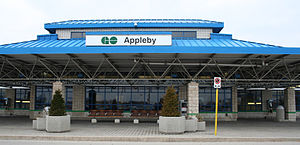 The province appears prepared to go to ridiculous lengths to get you to use the GO trains On October 17, a sign will be installed on the QEW near Appleby GO station displaying information about upcoming GO train trips departing from that station. The information will factor in the time it takes to drive there, park and catch the next available train. By the end of the year, the pilot will expand to Bronte and Oakville GO stations.
Let me see if I understand this. I am in my car on the QEW, heading east for an appointment or maybe driving to the Rogers Stadium to watch a baseball game. And the sign on the highway is supposed to convince me to hang a right and head for the GO station and take the train instead. Did I get that right?
The media release doesn’t say how much the province is spending on this initiative – nor do they make any mention about how they will measure the success of the idea.
This one has the look and feel of the road diet we put New Street on.
Where do these ideas come from?
Is there something in the water we drink?
Maybe I misunderstood the purpose of this project.
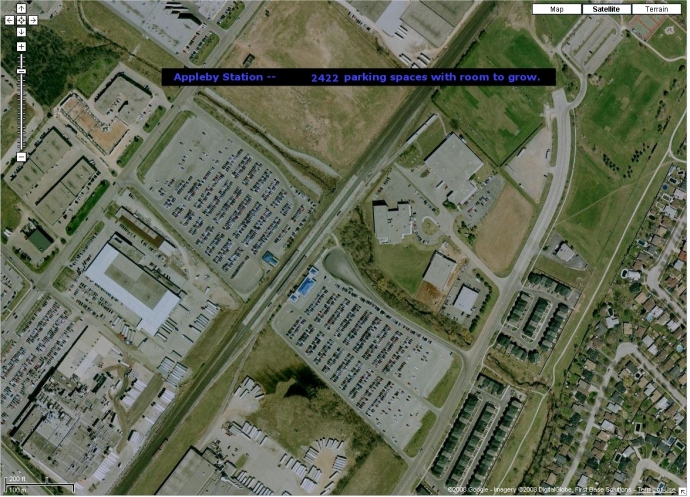 While there may be close to 3000 parking spots – finding an empty one can b a challenge at times. Reminding me that the GO train is a very good alternative, perhaps even better than driving to get me to the stadium to watch the ball game – and if you know anything about parking prices in Toronto – it is a better alternative.
Telling me that this is a better alternative while I am already in the car. I don’t know about me changing my mind just like that.
The media release did tell me that the Appleby GO station has 2,964 parking spaces. As part of the pilot, technologies will be evaluated that determine real-time parking availability at GO stations. This information could also be displayed on the signs.
The two Jane’s going after the Progressive Conservative nomination to be the candidate for that party are going to have a field day with this one.
Jane McKenna and Jane Micheal have announced they are going after the nomination.

 By Staff By Staff
October 13, 2106
BURLINGTON, ON
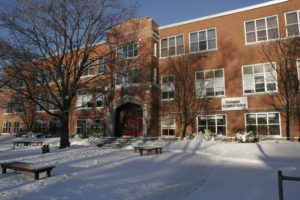 To a considerable degree the group of parents working to ensure that the Burlington Central High school is kept open are working on the fly. They are nimble, quick to spot the changes that have to be made and, if you ever wanted to see what collaboration is all about – sit in on a couple of their meetings. To a considerable degree the group of parents working to ensure that the Burlington Central High school is kept open are working on the fly. They are nimble, quick to spot the changes that have to be made and, if you ever wanted to see what collaboration is all about – sit in on a couple of their meetings.
If there were any egos to be seen – they got checked at the door.
Most are young professionals who are way past the getting signatures on a petition. These people understand policy and they focused on strategy right from the beginning – they are focused and determined. The smarter people at the school board will want to pay attention to these people – they are the ones that will be coming up with the solutions.
The Facebook set up they are using has been changed – the NEW Facebook address is set out below.
https://www.facebook.com/centralstrongBCHS/?notif_t=page_fan¬if_id=1476309799742119
The introduction to the Facebook page says it “was created by the committee of parents/residents and alumni (replaces the Group that was started) to keep the downtown core community informed on the HDSB’s proposal to close Central High School in 2018. The Board of Trustees’ final vote would be in May 2017, and the recommendation to close schools may change based on public input. It is important for us to share info and keep you informed of important meeting dates where you can provide ideas and feedback.”
While the Gazette can report on much of what the group does – their Facebook page will probably be the core source for information on an hour to hour basis. Bookmark it.

 By Pepper Parr By Pepper Parr
October 13, 2016
BURLINGTON, ON
It was interesting, exciting and exhilarating to watch some 60+ parents, several with children in tow and babies in carriages talk about how they will go about ensuring that those children have a high school to go to. The Parent Council at the high school did a superb job of both organizing and pulling together information. A quick look at the sheets of notes highlights how thorough they are going to be.
The trustee for the ward was doing what she is supposed to do – advocate for her constituents. The ward Councillor did her job as well. Her “I am here for you” was what the room needed to here.
If one can assume that all four trustees are on side for keeping Burlington Central High open – that gets 4 of the 11 votes. What about the two more that will be needed to ensure that the proposal to close BCHS is not approved by the trustees?
As an aside it looks like the parents with students going to Lester B. Pearson are comfortable with the decision to merge that school with M.M. Robinson.
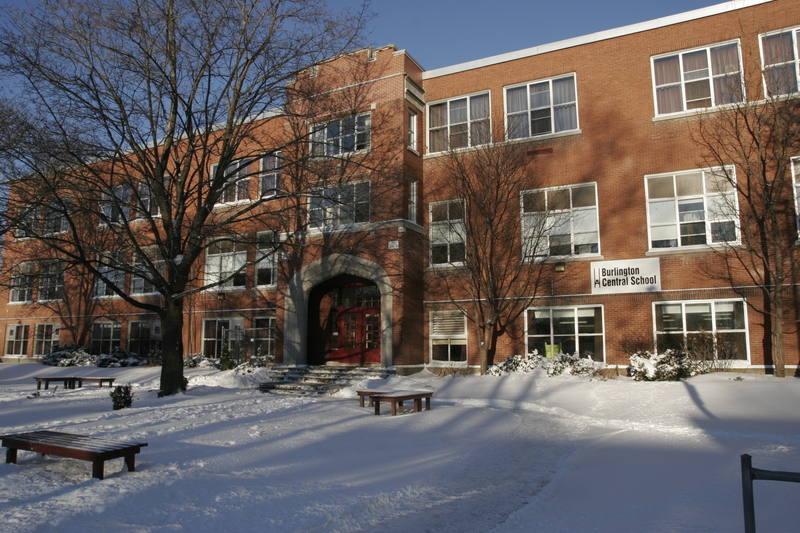 The potential to become one of the best high schools in the province rests in the hands of the Parent Council. The people taking part in the first BCHS community meeting were active, engaged and offered some superb comments.
This is their school – and this may be the opportunity for the community to not only oppose the closing of the school but put together ideas and proposals that would make the place one of the best in the province in terms of where students go for their education.
The structure has a sense of style and solidity to it. It is in the downtown core.
It does need a makeover which if done properly will make the school the one many students will want to attend.
It is already unique with its K to graduation set up. It has a very significant number of bursaries and scholarship available to students.
 These are the people that can make their school into whatever they want it to be. It has a parent population that in 1975 raised $100,000 to, we are told, refurbish the auditorium. Those were 1975 dollars.
This is a group of people who should not limit themselves to the just keeping the school open.
Dare to be Daniel’s and show your Board of Education that you have a vision for your community school.
Salt with Pepper is an opinion column publish from time to time

 By Pepper Parr By Pepper Parr
October 12th, 2106
BURLINGTON, ON
The Halton District school Board recently decided that they needed to look at the number of high schools it would operate in the city of Burlington.
The review becomes necessary when the number of students in the school falls below a specific number – 65% of the schools capacity.
The school board staff set out a list of 19 options; the 19th was the one chosen for a review. The decision to do a review is made by the trustees.
 Parents packed a meting Room at Wellington Square United Church – they will be doing that frequently in the next nine months. Last night more than 60 parents met at the wellington Square United Church in a room that was packed and decided what they wanted to do about any possible closure of the Burlington Central High school.
They got an overview of what happened in 200 when Terry Ruff was the newly appointed principal at the high school learned that he might have to close the school. Ruff, a Burlington native, was also a Central high school graduate. They managed to beat back the idea of closing the school then – the community faces that same issue 16 years later.
These parents are not going to go quietly into the night. The meeting was to begin the process o getting themselves organized. They set up four committees:
Executive/Organizing committee: set agendas/meetings; includes Team leaders
Strategy Team
Logistics team: volunteer intake & assignment; coordinate topic Teams
Fundraising/Communications Team (social media, GOFundMe)
The following four people from the high school parent council are:
Michael Kukhta – Neighbourhood Meeting Facilitator/ BCHS Council Chair
Lynn Crosby – Neighbourhood Meeting C0-Facilitator/ BCHS Council Secretary
Dania Thurman – Neighbourhood Meeting Facilitator/ BCHS Council Vice-Chair
David Sykes – Neighbourhood Meeting Facilitator/ BCHS Council Treasurer
Where are they at and what are they up against?
Dropping enrolment and other factors trigger a proposal for a Program & Accommodation Review (PAR) for all Burlington secondary schools.
The HDSB Director of Education gets staff to write a report to which is given to the elected Trustees recommending that a PAR be undertaken. Of the 19 options in the report staff recommended using Option #19 as starting point for discussions.
 Burlington central High school was seen as being very close to the point where there are not enough students to justify keeping it open – parents think the numbers the board is using might be suspect. Option #19 recommends closing Burlington Central High School, and Pearson High School.
Close BCHS; students west of Brant St redirected to Aldershot HS; students east of Brant St redirected to Nelson HS
Close Pearson HS; students redirected to MM Robinson HS, including those in Late French Immersion program
French Immersion eliminated from Dr Frank Hayden SS: FI students north of Upper Middle Rd redirected to MM Robinson HS
New FI program started at Robert Bateman HS: FI students south of Upper Middle Rd attending Hayden SS redirected to Bateman HS; FI students east of Appleby Ln attending Nelson HS redirected to Bateman HS
English program students south of Upper Middle Rd attending Hayden SS redirected to Bateman HS
The parents at Central high school, with very strong support from their municipal councillor Marianne Meed Ward are opposed to closing their high school.
The trustees were given the report on October 5th. On October 19th the trustees vote on whether to undertake a PAR. Assuming they do, a PAR Committee (PARC) Established on December 1st.
That committee will include:
Trustee from outside Burlington
Superintendent from outside Burlington
Principal or designate from each affected high school
Two parents/guardians from each affected high school
Once PARC is formed, municipal councillor or delegate is invited
HDSB staff are available as resources from specific HDSB departments including (not limited to): School Programs, Special Education, Human Resources, and Planning.
The goal the Central high school parents have set out for themselves is to participate fully in the Program & Accommodation Review, including HDSB Trustee meetings (Oct. 19 – vote on PAR; April 18 – public delegation meeting, May 3, May 17 – decision date) and public meetings (Dec. 8; March 2). Final report ready: March 29, 2017
 Boiling all this down to the five key points is going to take a lot of work – the parents appeared to be up to the task if their first meeting is any indicator. Throughout the process they intend to make their case that Central high school should be kept open. They will be collecting their own data and evidence and first-hand knowledge and stories
To build their case they are assigning different topics to research/write/present.
The parents are very concerned about Walkability – their want their children to be able to walk to school. They are firm in their belief that much of the data the school board is using comes from outdated statistics; faulty enrolment projections, and a misunderstanding of downtown growth.
They point to the problem in Alton where a band new high school was opened two years ago and is overenrolled due to multiple families living in the same household. The board staff weren’t aware that multiple families were living in the one house.
The parents are suggesting that the data doesn’t always reflect reality on the ground.
The impact on the feeder schools: Lakeshore, Tom Thompson, Central elementary is a concern.
The audience was told that schools cannot be closed in what are defined as Urban Growth Centres in the Provincial Places to Grow plan,
The audience was told that the staff report is thorough and that the focus of the report is on programs for students; heritage is on the list but it didn’t have much in the way of priority.
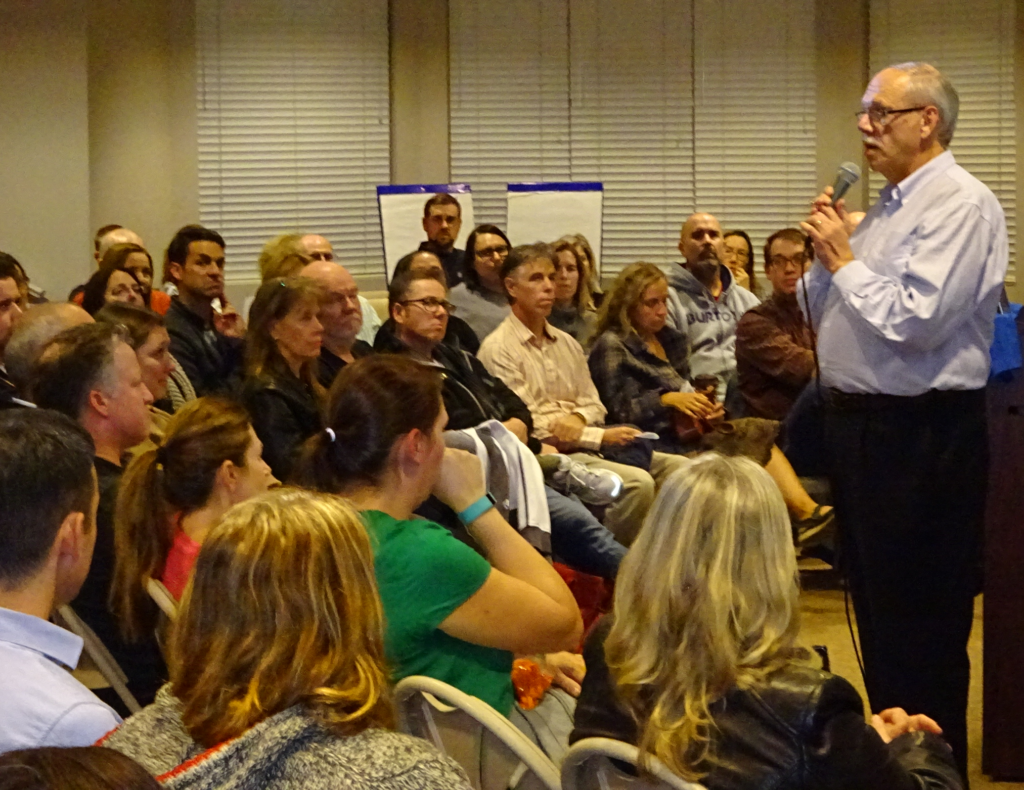 Former Burlington central High school principal Terry Rugg explained to parents what had to be done in 2000 when the board o education wanted to close the high school. The parents seemed to be focused on “community” and the role schools play in the creation of community. Central is the only school in the Region that is a K to graduation school – the parents don’t want to lose that feature of their community.
Because it is an older school there are a lot of scholarships and bursaries attached to the school – what would happen to those were the high school to close?
Admittedly, the school could use some upgrading – it is an old school and it needs some help – bu it certainly doesn’t need to disappear.
In 1975 $100,000 was raised by the community to upgrade parts of the school.
Data available to the parents’ points out that household income for the Central high school catchment area is the lowest in Burlington – how are those low income families going to handle the cost of transportation to Nelson or Aldershot?
They point out that the report doesn’t offer anything in the way of a solution on what will happen to the grade 7 and 8 students should the high school be closed.
This is going to be a very active story and one that is critical to what kind of a downtown core community the city is going to have – these parents are not going to sit still and lose their high school.
There will be a web site with all the data and reports. The Gazette will let you know when it is up.
There is a Facebook page with 1500+ people looking in.
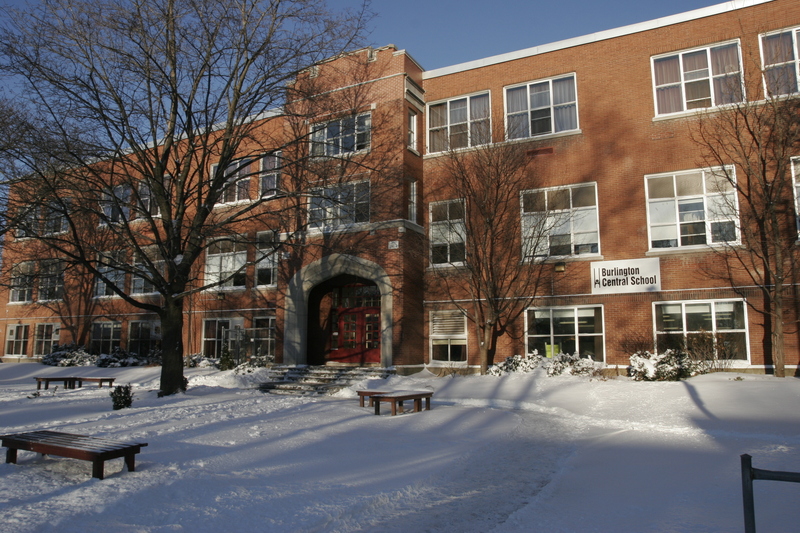 Can the parents convince the Board of Education to keep the school open? The committee has collected $1750 of the 42500 target they gave – these funds will be used to print lawn signs and pay the rental fees for the space they use for their meetings.
What the parents are going to have to watch very carefully is how the Board of Education chooses to interact with them. Tread carefully was the advice given to the meeting.
Central High school is critical to the kind of downtown community the city has – there is a seperate high school a stones throw away.
What doesn’t exist is a committee where the city and the board of Education meet to thresh out issues. Truth be told – the two organizations don’t get along all that well and tend not to cooperate very well.

 By Pepper Parr By Pepper Parr
October 10th, 2016
BURLINGTON, ON
As we move into the Thanksgiving weekend teachers in the Region use one of their Professional development days which closes the schools for four days.
Most of us will sit at tables filled with platters of food and enjoy time with our families.
It is weekends like this that keep the volunteers at Food4kids busy – they pack food for kids that go home to a fridge that is pretty empty – no turkey on their plates.
Gayle Kabbash reports that 329 healthy food packages were given to children in Halton and 758 in Hamilton this week. “Our numbers will increase as we are higher at this time of year than last year.”
 Food in a bag. Food4kids is just one organization that helps students in need – there are a lot more of them than most people are prepared to admit.
Sheri Armstrong, with the Learning Foundation reported that just 16 days into the school year there were 80 request for aid; compared with the 40 at the same time last year.
The Halton Learning Foundation (HLF) partners with individuals, corporations and community foundations to eliminate financial barriers to education for public school students in Acton, Burlington, Georgetown, Milton and Oakville.
They provide assistance through emergency funds for students-in-need, post-secondary scholarships, and engagement funds that help schools purchase tools and resources to engage students in learning.
With public support, HLF helps ensure that every student of the Halton District School Board has the chance to fit in at school, to have the same experiences as their peers, to be engaged in learning, and to explore possibilities for the future.
The Learning Foundation has provided Eliminating Barriers funds to virtually every school in communities across Halton. The majority of Burlington schools (95 per cent) have received Eliminating Barriers funds to help students in the last two years.
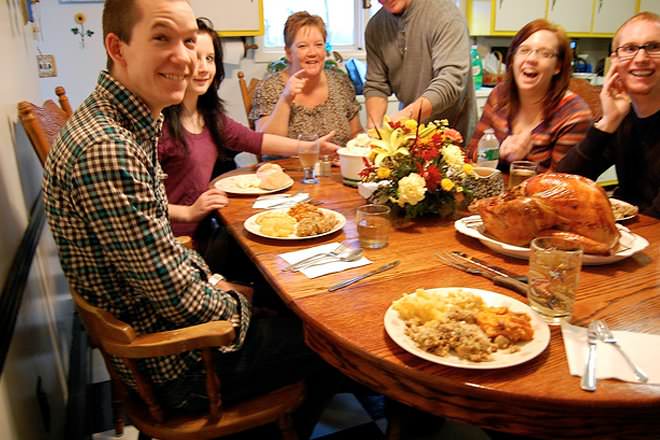 Thanksgiving – food on the table. The odds are that there is more than one students in the life of your children who are in need of the basics like food or clothing or who are unable to participate in the class trip or other school activities.
We have much to be Thankful for today – hopefully we will find a way to help those that don’t have quite enough.
Halton Learning Foundation –
Eliminating Barriers
Food4kids –
https://www.food4kids.ca/

 By Staff By Staff
October 8th, 2016
BURLINGTON, ON
The Gazette asked Halton District school Board trustee Richelle Papin, ward 4, if she had made any plans to respond to the decision the board has made regarding the possible closing of the Lester B. Pearson high school?
Papin’s response:
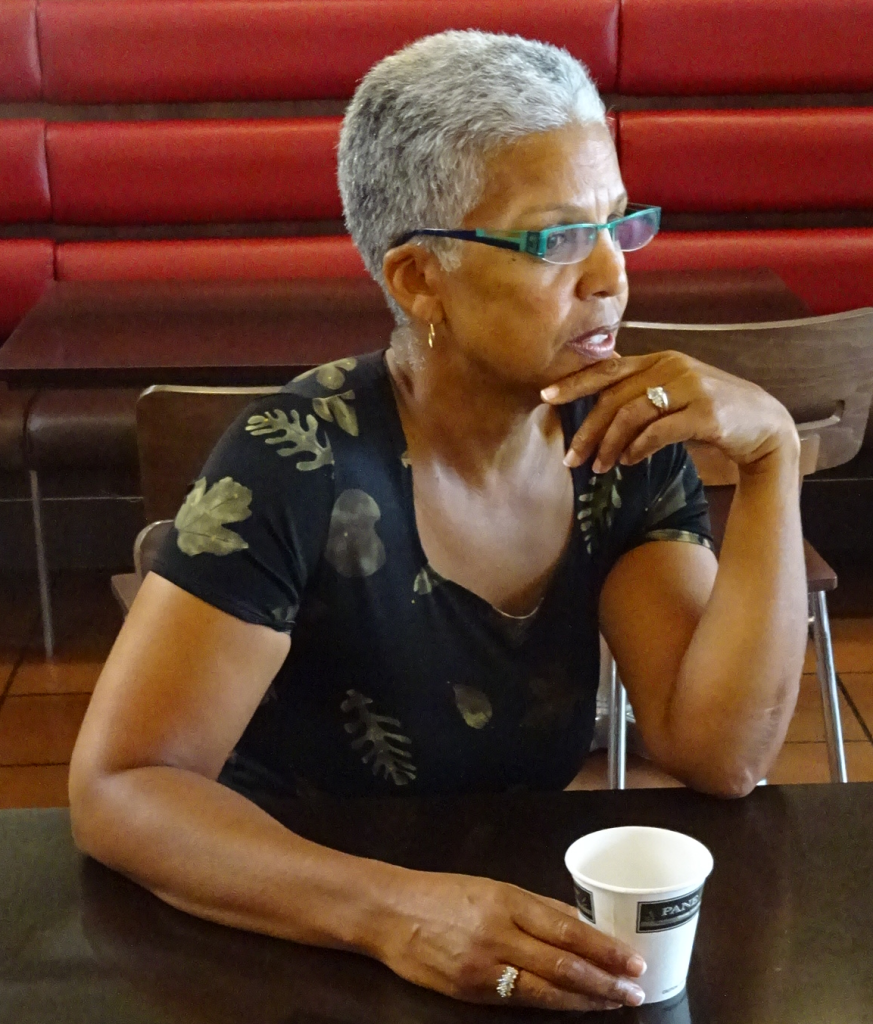 Halton District School Board trustee Richelle Papin. Trustees should not be responding to the recommended option the report acknowledged regarding the possible closing of the Lester B Pearson High School. I’m not sure if the question can be answered right now. The director has presented a report regarding bringing forward a Program and Accommodation Review for Secondary Schools in Burlington. Part of the report, Ministry, requirement, is that the report must include a recommended option.
This is only one option which could very likely change after the PARC is completed.
Due to low enrollment, underutilization in a number of Burlington secondary schools and the possibility of inequity in education for some secondary students, the director is recommending that the Halton District School Board undertake a Program and Accommodation Review (PAR).
If the Board of Trustees approve the report, the Program and Accommodation Committee will begin the PAR. At this point, I need only respond to whether I agree that the report should be approved or not approved to begin the process. The trustees as a group will do that when we vote on Wednesday, October 19, 2016.
The Gazette asked if Papin planned on organizing a public meeting. Her response:
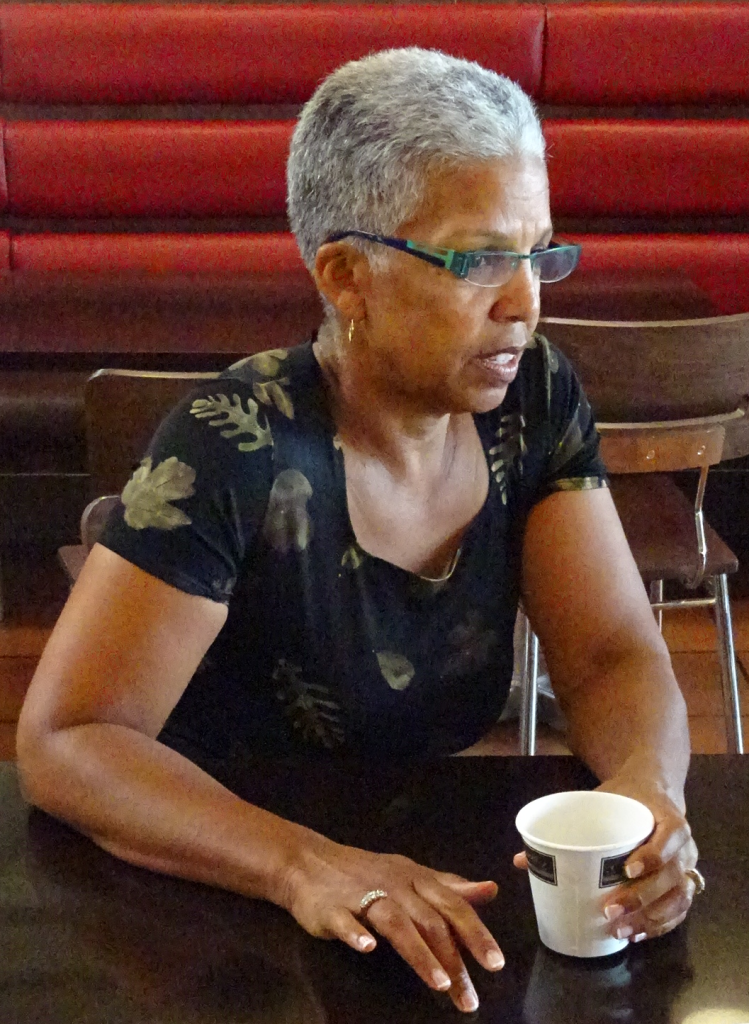 Trustee Papin has not yet made any comment on what she thinks should happen to Lester B. B> Pearson high school nor has she commented on the views of parents in her ward. These may follow when she returns to Burlington from a short Thanksgiving vacation. The four Burlington trustees are planning a Super Council meeting for Monday, October 24, 2016 at the JWS office, Board Room for 7 pm to 8:15 pm. We will be meeting with the Director, some Superintendents, Principals and Secondary School representatives. The public is welcome.
Papin was out of the country limiting communication.
Parents in the downtown core concerned about the possible loss of Central High school have organized a meeting at Wellington Square United Church for Tuesday evening – October 11th at 7 pm.


 By Pepper Parr By Pepper Parr
October 4th, 2016
BURLINGTON, ON
Burlington does not take to change all that well.
A change in the configuration of traffic lanes on New Street has everyone up in arms – both those wanting the change and those opposed to a change.
The Halton District School Board has told the public, via the release of the agenda for the October 5th regular board meeting, that two of the city’s high school “could” be closed effective June 2018.
Burlington has seven high schools:
Aldershot High School,
Burlington Central High School,
Dr. Frank J. Hayden Secondary School,
Lester B. Pearson High School,
Nelson High School,
M.M. Robinson High School and
Robert Bateman High School
A recommendation to close two of the seven Burlington Central High school and the Lester B. Pearson high School, has left the community thunderstruck.
 Central High – the school in th downtown core is where the biggest battle to remain will take place. The ward alderman has already come out against closing the school – fortunately the school board trustee might give the decision more thought and wait until there is more in the way of public feed back. Feathers flew, school board trustees were inundated with phone calls and emails. One can expect all kinds of misinformation to get in the way of what the board is being asked to approve.
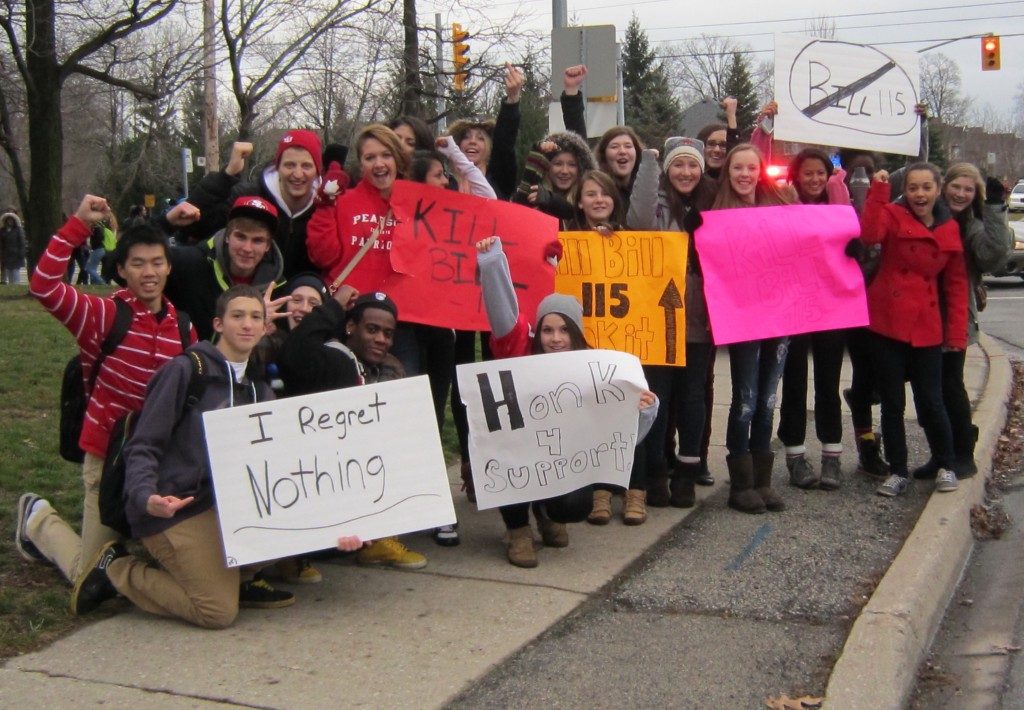 The spunk and school pride at Lester B. Pearson may not transfer to M.M. Robinson where most of the students will transfer to in the 2019 school year. Some things to keep in mind: Staff prepare reports, they work within the provincial guidelines and have a collection of acronyms that that can’t be used in a Scrabble game. The staff report goes to the trustees – those men and women you elected two years ago – they are going to make the decision on your behalf.
There is a well-developed process for community input – use it before you lose it.
The proposed time line, assuming the trustees, go along with the staff recommendation is as follows:
If the Program and Accommodation Review proceeds as scheduled the following is a proposed timeline for the implementation staff recommended (they are considering 19 different options)
Completion of a PAR with a Final Decision in 8 – 9 months
Capital Priorities Application and Funding takes 3 – 6 months
Transition Planning takes 1 year
Pre-Construction and Construction (project dependent) 1-3 years
School Closing June 2018
Now to those acronyms – try to remember them – the process doesn’t make much sense without some understanding of what the Gazette has come to call “board speak”
PAR – Program and Accommodation Review
As outlined in the Board PAR policies, the Director must prepare a Preliminary Report which identifies a school or group of schools that may be considered for a Program and Accommodation Review. In order for a PAR to be initiated, one of five conditions must be met. The conditions are as follows:
1. The school or a group of schools has/have experienced or will experience declining enrolment where On-The-Ground Capacity (OTG) utilization rate is below 65%;
2. Reorganization involving the school or group of schools could enhance program delivery and learning opportunities;
3. Under normal staffing allocation practices, it would be necessary to assign three or more grades to one class in one or more schools;
4. The current physical condition of the schools negatively impacts the optimum operation of the building(s) and program delivery;
5. In respect of one or more of the schools under consideration there are safety, accessibility and/or environmental concerns associated with the building of the school site or its locality.
LTAP – Long Term Accommodation Plan is something done by all school boards annually. The plan is adopted by the Board of Trustees. The document provides enrollment projections for the upcoming ten years for all schools in Halton.
PARC Program and Accommodation Review Committee is an advisory group that acts as an official conduit for information shared between the Board of Trustees and their communities. The PARC will meet, review information, provide feedback from the community, and suggest options.
Each PARC consists of a Trustee and Superintendent from an area outside of Burlington; Principal or designate, two parents/guardians
Utilization rate – the percentage of the capacity that is being used.
 The table set out above shows enrollment estimates for the next ten years, the capacity of all the high schools in the city; the percentage of that capacity that is being utilized and the amount of space that is available. These numbers are for all the high schools – a breakdown of the numbers for each school is set out below. Staff are recommending that two high schools be closed in June of 2018:
Lester B. Pearson be closed and the current student population be sent to M.M. Robinson which is 1.6 km away.
 The Utilization rate is just too low to justify keep the school open. Lester B. Pearson High School, Grades 9-12, located north of the QEW between Guelph Line and Walker’s Line. The school offers English and Late French Immersion programming. It is the only school in Halton to have Late French Immersion. Late French Immersion begins in Grade 7 at Sir E. MacMillan Public School. Growth from infill developments are included in projections. The utilization is 65% and it is expected to decline. There currently is an excess of 220 spaces in the facility. Enrollments in Grades 9-11 English are expected to be less than100 students per grade. The board staff may have failed to recognize the changes taking place between Guelph Line and Walkers Line – east and west and between Upper Middle and Mainway – north south. Real Estate agents will quickly tell you that multiple families are living in a single detached house with basements being converted into a bedroom for four and six children. Many of these families are from the Middle East and culturally they are comfortable with a large family in the house – this is the way they choose to live because it is the only way they can afford houses in that community.  The Burlington Central facility houses elementary and secondary school classes (Grades 7-12) and is located within the downtown core. Combined with adjacent Central PS (K – Grade 6), this facility forms a part of a K-12 campus. This school offers English and French Immersion programming. Enrolments are projected to be stable. Growth from infill developments are included. The high school’s utilization is expected to remain stable at 68% capacity. In 2015, there were 376 available pupil places in the facility. Burlington Central is the only facility without an elevator/stairlift. The sports field lands are not owned by the Halton District School Board. Staff is recommending that Burlington Central HS be closed effective June 2018. All secondary students, west of Brant St., will be redirected to Aldershot HS and secondary students east of Brant St to be redirected to Nelson HS.
This recommendation does not include the redirection of Grade 7 and 8 students from the Burlington Central Elementary PS.
In the event that the decision is made to close this high school, there is a potential that a Program and Accommodation Review may be required for the elementary schools that currently feed into Burlington Central PS for Grades 7 and 8.
The enrollment, utilization ans space available in the other five schools is as follows:
 Located within the Aldershot community in southwest Burlington, the Aldershot facility houses elementary (Grades 7-8) and secondary classes (Grades 9-12). It is the only Grade 7-12 school available west of QEW/407 ETR. This school offers English and French Immersion programming. Enrolments are projected to decline beyond 2020. In 2015, there were 327 available pupil places in the facility. Growth from infill developments and North Aldershot Planning Area developments are included in the projections. The high school’s utilization is currently 78% and is expected to increase to 83%, by 2019. It is projected there will be close to 100 English secondary students per grade (excluding Grade 12). Aldershot High School
 Nelson High School, Grades 9-12, is located south of the QEW between Walker’s Line and Appleby Line. This school offers English, French Immersion, and Secondary Gifted Placement. Enrolments are expected to increase over the next ten years. Growth from infill developments are included in the projections. Nelson HS utilization rates are expected to remain above 80%. Nelson HS has the second highest high school utilization in Burlington. There is an excess of 343 available places at this school in 2015. There is support for a Nelson Stadium Revitalization project between the community, Board and Burlington staff. Nelson High School
 M.M. Robinson High School, Grades 9-12 is located north of the QEW between Guelph Line and 407 ETR. The school offers English, French Immersion and SC-SPED programming. It is one of two schools to offer SC-SPED programming in Burlington. The SC-SPED program was added to the school in 2013. Growth from infill developments are included in the projections. The utilization is below 55% and is expected to decline. There is currently an excess of 617 spaces in this facility. M.M. Robinson High School
 Robert Bateman HS Robert Bateman High School, Grades 9-12, is located south of the QEW between Appleby Line and Burloak Drive. A small area known as Samuel Curtis Estate in Oakville is directed to this school. The school offers English programming, International Baccalaureate programming (IB) and a variety of Self Contained-Special Education (SC-SPED) programs. Robert Bateman High School is the only school in Burlington to offer the IB program. This program attracts students from senior elementary schools in the Burlington area. This high school is one of two schools to offer SC-SPED classes and as such, this school has specialized facilities to accommodate the programs. Growth from infill development is included in the projections. Utilization is below 65% and is expected to decline. There currently is an excess of 500 spaces in the facility. The combined English program and IB program is expected to be under 100 students per grade (excluding Grade 12), by 2022. Hayden is already over-utilized and there are three new developments that are going to feed into the school – the third is the development at Dundas and Walkers Line.  Dr. Frank J. Hayden Secondary School, Grades 9-12, is Burlington’s newest high school located in Alton Village, north of Dundas St. It opened in 2013 and offers English and French Immersion programming. Enrolments are expected to increase. It is the only high school in Burlington that is currently above total capacity (2016) and is expected to continue to grow until 2021. Growth from new development west of Guelph Line and north of Dundas Street, and infill development is included in the projections. Current utilization is 118%. A major development application has been submitted after projections have been created for the 2015-2016 LTAP in the Evergreen Community, located north of Dundas St., and west of Tremaine Line. This area has not been assigned to a specific school. The development consists of 907 residential units. The City of Burlington is in the midst of creating a secondary plan. It is anticipated that there will be approximately 50 secondary students from this area. The closest high school to this development is Dr. Frank J. Hayden SS. Using the space that is available in a school if there aren’t enough bums to put in the seats.
The province recently gave the school boards permission to rent out some of their space to community organizations.
The Community Planning and Partnership Guidelines directs Boards to identify potential partnership opportunities and to share such opportunities with government agencies and parties that expressed interest for such opportunities.
In response, the Halton District School Board adopted the new Community Planning and Partnership Policy on October 21, 2015. The first annual Community Planning and Partnership meeting was held on June 22, 2016, in Burlington.
Approximately eight organizations had representatives at this meeting. There have been three follow up meetings and preliminary inquiries with interested partners since June 2016. At this time, there has been expressed interest in potential partnerships, but no specific details related to a partnership within a Burlington secondary school.
So that opportunity isn’t going to save either of the two high schools.
What is possible with both is re configuring them into affordable housing which is a Regional responsibility. However, surely the Region could pick up the telephone and call the school board and ask: ‘What do you think of the idea of selling the buildings to a developer we can convince to take on such a project.’
Have a chat with the four major developers who want some additional height and density and suggest a proposal to turn a high school into affordable housing units might elicit a favourable response to more height and density.
None of the developers in this city are interested in including affordable units in their buildings – they are marketing a lifestyle that doesn’t include people who can’t afford a unit that is going for something north of $400,000
Closing one high school in a community the size of Burlington would be a big deal – suggesting that two be closed at the same time is a bigger piece of meat than th school board can chew through in the time frame they have given themselves.
These decisions are Burlington decisions – but there are school board trustees from Oakville, Milton and Halton Hills – what impact will their votes have on a Burlington situation?
Interesting times ahead – stay tuned.

 By Pepper Parr By Pepper Parr
October 4th, 2016
BURLINGTON, ON
I’d heard about it; drove by the place hundreds of times, knew what it was but had never had a chance to actually go into the place.
It was the Union Burial grounds on Plains Road established in 1848 by ten pioneer families who were members of the Methodist Union.
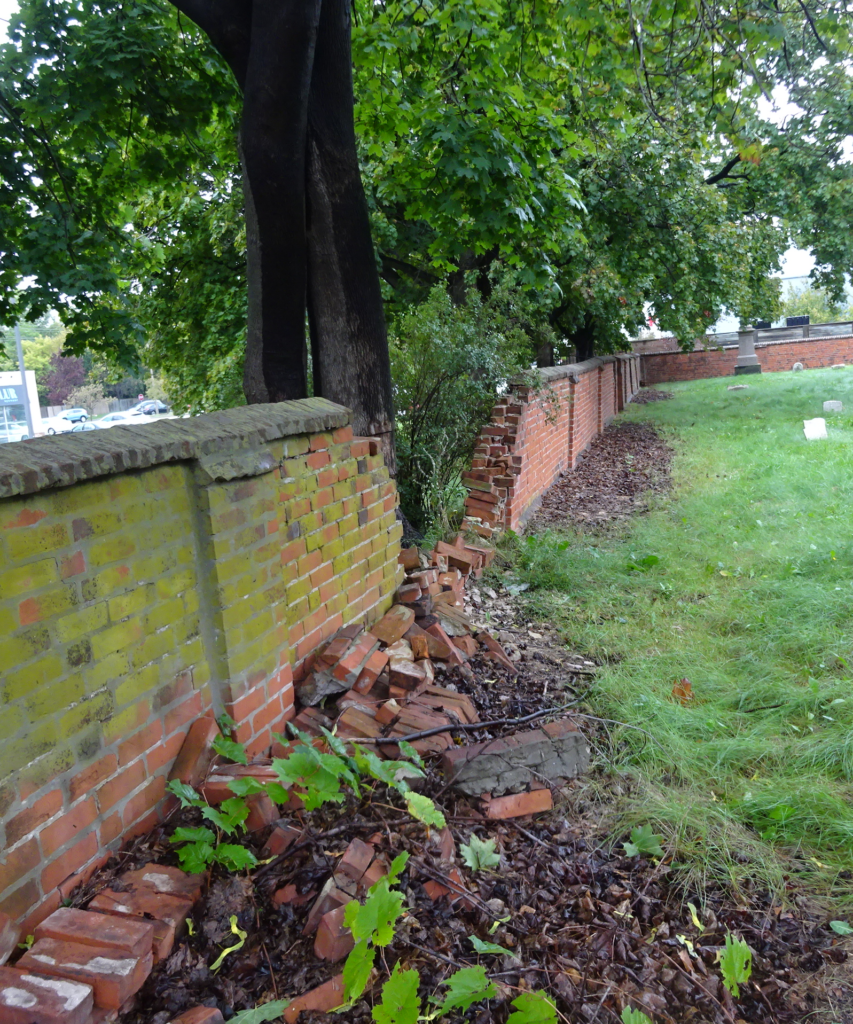 A brick wall, first built around 1882 to enclose the Union Burial grounds, now needs both renovation and repair The chief architectural feature is the fine brick wall surrounding the 138-by 104-foot burying ground. The wall was built around 1882 by brick mason Jabez Bent. There are also fine wrought iron gates at the front and side. The memorial markers commemorate some of the earliest pioneers in this area.
The site was originally farm land owned by Asahel Davis, a Methodist, a community who wanted burying grounds separate from those established by the Anglican Church at St Luke’s and St John’s. Religious differences were a big deal in those days.
 The Ghent’s were prominent farmers in Burlington. Both Thomas and hos wife Elizabeth rest in the Union Burial grounds. The families holding plots in the Union cemetery were major contributors to the early growth, prosperity, and well-being of Nelson and the Village of Wellington Square which are parts of what we know as Burlington today.
The Baxter’s, the Crosby’s, the Cummins’s, the Davis’s, the Fisher’s, the Gage’s, the Galloway’s, the Ghent’s, the Kerns’s and the Pearl’s – the families whose names identify many of our strrets created their own cemetery.
It is quite run down these days. The families moved on and there aren’t that many descendants of its founders around to continue to manage and maintain this historic burial place.
The brick wall is, sadly, in need of restoration. The wrought iron gates and original name plaque also date from 1888. The grave markers are invaluable historic records and also merit preservation. This cemetery feels especially unique given it’s setting of urban development.
“The families who created this cemetery came to Canada during the American Revolution. They were British and chose to remain part of the British Empire in North America. The Americans were in the process of creating their own country, there were just 13 colonial states at the time, who didn’t want the British imposing taxes on them. Out of the struggle between the Thirteen Colonies and their mother country emerged two nations: the United States and what would later became Canada.
 The smaller markers recognize members of the family – several for children that died at a very young age. “Those that left the colonies became known as The United Empire Loyalists who wanted to remain faithful to the Crown and wished to continue living in the New World. Therefore, they left their homes to settle eventually in what remained of British North America.
For many years after those people would put the letters UE after their names – United Empire. Many of the markers in the Union Burial ground have those letters on the stones.
“The Loyalists came from every class and walk of life. Some depended on the Crown for their livelihood and status and had considerable wealth and property. Many were farmers and craftsmen. There were clerks and clergymen, lawyers and labourers, solders and slaves, Native Americans, college graduates, and people who could not write their own names. Recent immigrants from Europe also tended to support the Crown.
“They had little in common but their opposition to the revolution. Their reasons for becoming Loyalists were as varied as their backgrounds. Some had strong ties with Britain: others had simply supported what turned out to be the losing side. Local incidents, fear of change, self-interest, political principles, emotional bonds – one or any combination of these influenced their decision to remain loyal to the Crown. The common thread that linked these diverse groups was a distrust of too much democracy which they believed resulted in mob rule and an accompanying breakdown of law and order. The Reverend Mather Byles mused, “Which is better – to be ruled by one tyrant three thousand miles away or by three thousand tyrants one mile away?” Loyalists believed that the British connection guaranteed them a more secure and prosperous life than republicanism would.
“Historians estimate that ten to fifteen per cent of the population of the Thirteen Colonies – some 250,000 people opposed the revolution; some passively, others by speaking out, spying, or fighting against the rebels. Approximately 70,000 Loyalists fled the Thirteen Colonies with roughly 50,000 settling in British North America.
“Of less practical value than land and supplies, but of more lasting significance to the Loyalists and their descendants, was the government’s recognition of the stand that they had taken. Realizing the importance of some type of consideration, on November 9, 1789, Lord Dorchester, the governor of Quebec, declared “that it was his Wish to put the mark of Honour upon the Families who had adhered to the Unity of the Empire…” As a result of Dorchester’s statement, the printed militia rolls carried the notation: U.E., alluding to their great principle The Unity of the Empire.
“Those initials “U.E.” are rarely seen today, but the influence of the Loyalists on the evolution of Canada remains. Their ties with Britain and their antipathy to the United States provided the strength needed to keep Canada independent and distinct in North America.
“In the two centuries since the Loyalists’ arrival, the myths and realities of their heritage have intertwined to have a powerful influence on how we, as Canadians, see ourselves. Truly, the arrival of the United Empire Loyalists not only changed the course of Canadian history by prompting the British government to establish the provinces of New Brunswick and Ontario, but it also gave them special characteristics which can be seen today. Perhaps the most striking of these is the motto on the Ontario coat of arms: Ut incepit Fidelis sic permanet that is, “Loyal she began, Loyal she remains.”
One of the people telling the story of the Union Burial grounds on Saturday was Stephen Davis, a surveyor who works for the Region; his descendants are buried on the grounds.
“We restored the rear wall and we will re-build the west wall. Trees planted too close to the wall grew and pushed over the brick work. It is a lot of work and we don’t have that much time – we are busy raising our family’s and some of the families buried here have moved on” said Davis.
Davis is working on some ideas on how young people can develop an interest in their ancestry and take part in the rehabilitation of a significant part of Burlington’s history.
Related articleL:
Large portion of this report came from a document written by Ann Mackenzie M.A.

 By Staff By Staff
October 4th, 2016
BURLINGTON, ON
Anishinaabe speaker, educator, and musician Eddy Robinson brings a wealth of knowledge and personal experience to the national conversation about Indigenous communities in Canada. He will be speaking at the Crawford Lake Conservation Area on Saturday, October 15, 2016 from 3:30 to 5:30 p.m.
Increasing media coverage of the challenges faced by Indigenous communities in Canada leaves many of us with questions about how such disparity can exist in our own country. Eddy will use his remarkable gift as a storyteller and teacher to bring this workshop to life and make the issues engaging for workshop participants.
 Crawford Lake, it is a meromictic lake meaning that it does not receive the same atmospheric disturbances as other bodies of water, so the water remains calm almost all the time. And this makes for some great photos and clear water to take a look at fish and other interesting features. A boardwalk surrounds the lake, so it is quite accessible to almost everyone. Come early for this remarkable workshop and you can explore the 15th century reconstructed Iroquoian Village and rare meromictic lake located onsite. Explore the past and then learn about our collective present, so we can make a more inclusive future.
“Through stories and song, Eddy works towards a day when the power of knowledge, inclusiveness and sharing of First Nations cultures helps our nation and all its’ people become connected and stronger.”
Tickets for the October 15 workshop at Crawford Lake are $25 per person (plus HST), you can purchase tickets online through the event listing at www.conservationhalton.ca/events.
Eddy Robinson, Indigenous Speaker, Artist, Musician & Activist was born to the Missanabie Cree First Nation, but born and raised in Toronto. Eddy didn’t enjoy an easy childhood as an Anishinaabe youth in the big city. His father, a Residential School survivor, left the family when he was just three years old and he subsequently endured years of abuse from an alcoholic parent. It was during these early years that he was first exposed to a heritage that he now credits with saving his life.
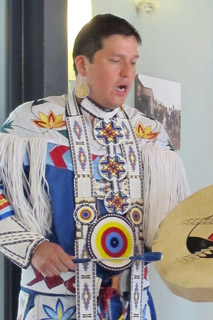 Eddy Robinson, Indigenous Speaker, Artist, Musician & Activist was born to the Missanabie Cree First Nation. Eventually ending up in the care of his grandparents, Eddy found himself on the same path of violence and addiction that dominated his childhood. He credits a Catholic priest at the Native Peoples Parish in Toronto for first encouraging him to seek out his roots. He pointed Robinson to a traditional Anishinaabe Vision Quest/Fasting ceremony that would begin his journey towards sobriety.
The power of the Dewegun (Drum) has opened the door to other aspects of his culture. A member of the Canadian Council of Aboriginal Business (CCAB) Eddy established his First Nations owned and operated business Morningstar River in 2007 to address the societal need for Indigenous education and displays of authentic culture. Eddy is a noted Anishinaabe artist, musician, activist and educator, and is a member of the National Speakers Bureau.
Crawford Lake is located at the corner of Guelph Line and Conservation Road (formerly Steeles Avenue) 15 km north of the QEW, and 5 km south of the 401 in Milton. The pristine waters of Crawford Lake have drawn people to its shores for hundreds of years. The rare lake, with surrounding boardwalk, is nestled in lush forests atop the stunning Niagara Escarpment where visitors can watch soaring turkey vultures glide through the Nassagaweya Canyon.
You can step back in time and explore the 15th century Iroquoian Village that has been reconstructed on its original site at Crawford Lake. The spirits still sing in the longhouses where tools, animal hides and the smell of smoke let you experience the rich history of Ontario’s First Peoples. Crawford Lake’s Customer Service staff can be reached by telephone at 905-854-0234, ext. 221, or by e-mail, crawlake@hrca.on.ca.

 By Pepper Parr By Pepper Parr
October 4th, 2016
BURLINGTON, ON
There was a time when everyone walked to school – you met up with friends at the end of your street and you walked as a small group with your friends and learned what real gossip was all about.
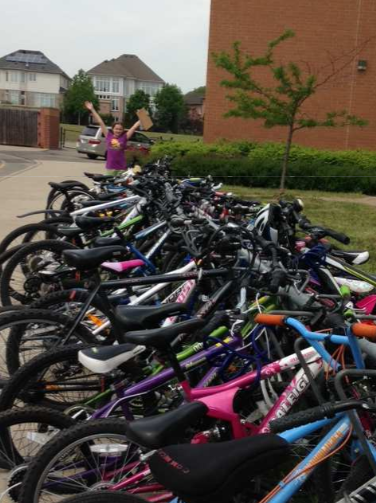 Bikes parked at the Beaudoin school. This doesn’t happen every day. When that practice came to an end – and why it came to an end is something the Gazette would invite some comment on.
Why do we insist in doing everything for our children? Are the streets of Burlington not safe?
The media release sent out by the school board uses the phrase “the need for safe places to walk”. Which streets to which schools in Burlington are unsafe?
“International Walk to School Day, October 5, began as a simple idea – children and parents, school and local officials walking to school together on a designated day. It is an energizing event, reminding everyone of the health benefits of regular daily activity, and the need for safe places to walk.”
“Suzanne Burwell, the Board’s Environmental Sustainability Coordinator says “Being active on the trip to school has a measurable effect on concentration levels”. She added that “Incorporating activity into morning routines is beneficial to the whole family, so if walking all the way isn’t feasible, consider connecting with other families to take turns walking with students, having students walk in groups or park legally a few blocks from the school, walk the rest, and start your day stress free.”
Do you get the sense that is a serious, significant commitment to convincing parents not to drive the kids to school?
I didn’t.

 By Pepper Parr By Pepper Parr
September 27, 2016
BURLINGTON, ON
So – you’ve been in business for a reasonable period of time and you now need to expand your reach into your market. Or you are climbing the corporate ladder and you want to grow your personal network.
Keith Hoey, president of the Burlington Chamber of Commerce told an audience of new members that people buy things from people they know” and added – “so get to know people – network, that is what the Chamber of Commerce can help you do.”
 If you had a question: Keith Hooey had an answer for you. All part of his regular new member orientation sessions. You know that networking is the key to it all – but where do you go to begin creating that all important personal network? Ask that question of Hooey, and he will whip out an application form faster than you can pull out a business card.
Hoey is passionate about the work he does. He is unrelenting and is also a very funny guy.
Last week, the Gazette sat in on an orientation session for new Chamber of Commerce members – there were about 35 people gathered at the Burlington Golf and Country Club.
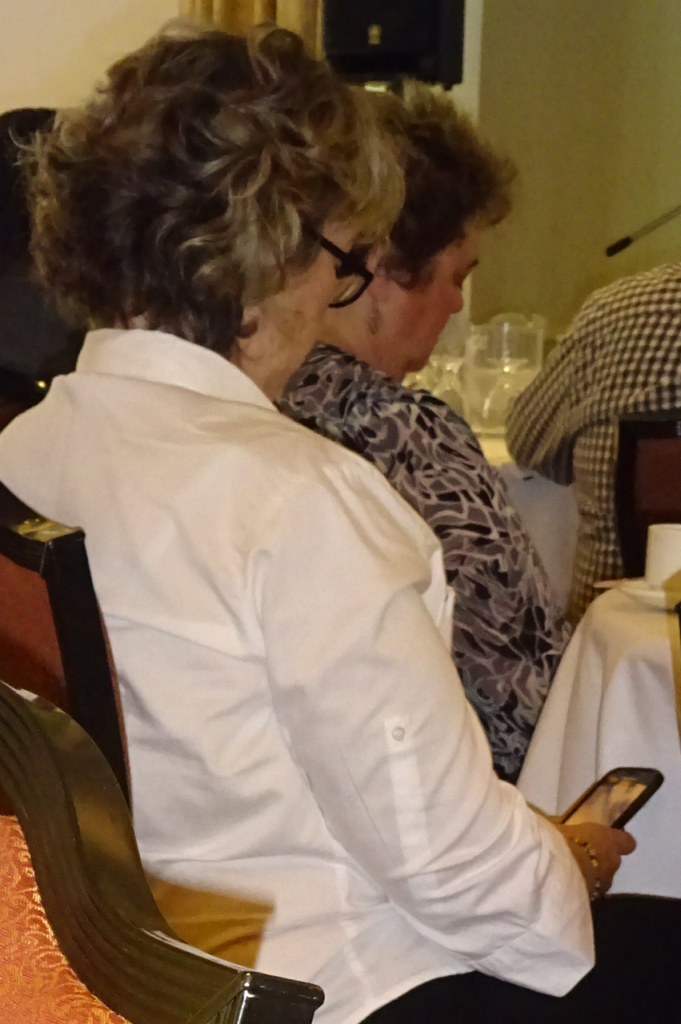 As interesting as Keith Hooey, president of the Chamber of Commerce was – there was business to be done. Hoey wasn’t selling memberships – the people in the room were already members – what Hooey was doing was explaining just how good a deal they had gotten themselves into.
The benefits were impressive – Hoey almost made it sound as if you could end up making money on a Chamber of Commerce membership. The 3.5% discount on gas purchases will certainly get you started on the savings side.
If you are a small business operator there is the opportunity to sign your staff up to a health benefits plan. The opportunities to meet people are abundant. There is he Before 9 crowd and the Business After 5 crowd that were described by Hooey as the best networking opportunities in the city.
The selling features that Hoey focused on were the Chamber’s three prime purposes: Networking, Education and Advocacy. The organization has over 1,000 corporate members, ran 103 events last year and has eight committees advocating on behalf of their membership.
How effective is the Burlington Chamber of Commerce in advocating or its members? Hoey gives on sterling example. There was a time when Burlington was short 22 doctors which was hurting companies that wanted to attract talent to the city. A committee was put together and after a period of time – these things do take time – a program was put in place that attracted doctors to the city – Burlington is now just two doctors short of what it should have the size of its population.
Hoey had one word of caution for the new members he was orienting – “I hope you joined because you are interested”. An uninterested member was a person Hooey would chat up and give them reasons to become interested.
One critical comment: Hoey will tell people to “get out there and make money”. One doesn’t hear him say – and “give back to your community”. Other than that he does a great job.
He gave the new members all the time they needed and answered all the questions they asked – and kept looking at the clock – checking the time.
Hoey was leaving for a Chamber trip to India – a part of the world he had not been to before. And he had yet to pack for his afternoon flight.

 By Staff By Staff
September 23, 2106
BURLINGTON, ON
The 7th annual Culture Days weekend kicks off next Friday, September 30 and runs through Saturday, October 1st and Sunday, October 2nd. Burlington is getting more involved than ever by making arts and culture accessible to the community.
This year’s Culture Days will feature many different types of artists, activities and events, including Doors Open Burlington us for the 5th year in a row.
Here is a breakdown of some of the events taking place:
Art Gallery of Burlington,
Burlington Libraries,
Burlington Performing Arts Centre,
Burlington Student Theatre,
Burlington Teen Tour Band,
On October 1st, Civic Square is transformed into Art in the Square, an event that runs from 2 to 5 p.m. Artists and artisans will showcase their artwork in a marketplace and provide interactive activities for the community. The event will feature live music and dance performances and provide the opportunity to be a part of the audience, explore various art techniques and try something new.
Doors Open Burlington
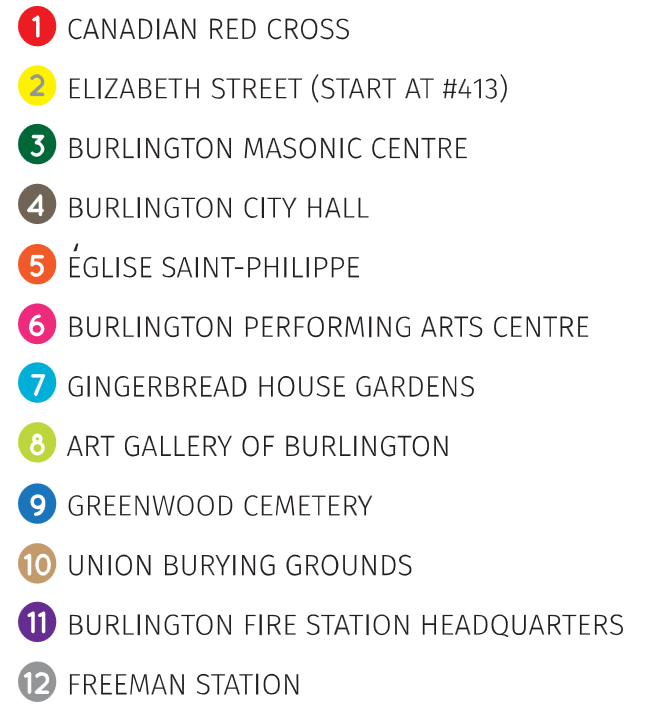 The 7th annual Doors Open Burlington takes place on Saturday, Oct. 1, 2016 from 10 a.m. to 4 p.m. It is an occasion to see your city from a different perspective and celebrate the cultural importance of the sites throughout the community. The event will highlight important buildings, organizations and landmarks that make Burlington a culturally vibrant place to live, work and visit. Admission is free! The 7th annual Doors Open Burlington takes place on Saturday, Oct. 1, 2016 from 10 a.m. to 4 p.m. It is an occasion to see your city from a different perspective and celebrate the cultural importance of the sites throughout the community. The event will highlight important buildings, organizations and landmarks that make Burlington a culturally vibrant place to live, work and visit. Admission is free!
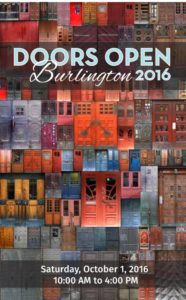 The city is a collection of doors – next weekend you get a chance to open many of them and take a peek inside. The Burlington Cycling Committee will lead a bicycle tour of the Burlington sites for the Doors Open event. Meet at City Hall, Civic Square at 10 a.m. and begin our journey to explore the sites. All ages are welcome and we will keep a leisurely pace using all available bike paths and bike lanes. There will be an opportunity to stop and visit each site. We estimate the cycle tour will take about two hours.
The looming question about this event is – will they drive along New Street and take advantage of those new bike lanes – and will that traffic count in the data the city is collecting.
Registration is required at the start of the tour.
Visit www.burlington.ca/culturedays to plan your weekend.

|
|
 By Pepper Parr
By Pepper Parr Taking place at Hamilton Artists Inc., 155 James Street North, Hamilton, Ontario. Attendance is free but registration in advance is requested by Wednesday November 2 at 5:00pm.
Taking place at Hamilton Artists Inc., 155 James Street North, Hamilton, Ontario. Attendance is free but registration in advance is requested by Wednesday November 2 at 5:00pm.


















 The parents at Pearson have begun their work – they do have some catching up to do and they do have a very unique situation to deal with: – The Co-op nursery that has been part of that school for more than 40 years which the Gazette will report on.
The parents at Pearson have begun their work – they do have some catching up to do and they do have a very unique situation to deal with: – The Co-op nursery that has been part of that school for more than 40 years which the Gazette will report on.
























 To a considerable degree the group of parents working to ensure that the Burlington Central High school is kept open are working on the fly. They are nimble, quick to spot the changes that have to be made and, if you ever wanted to see what collaboration is all about – sit in on a couple of their meetings.
To a considerable degree the group of parents working to ensure that the Burlington Central High school is kept open are working on the fly. They are nimble, quick to spot the changes that have to be made and, if you ever wanted to see what collaboration is all about – sit in on a couple of their meetings.



























 The 7th annual Doors Open Burlington takes place on Saturday, Oct. 1, 2016 from 10 a.m. to 4 p.m. It is an occasion to see your city from a different perspective and celebrate the cultural importance of the sites throughout the community. The event will highlight important buildings, organizations and landmarks that make Burlington a culturally vibrant place to live, work and visit. Admission is free!
The 7th annual Doors Open Burlington takes place on Saturday, Oct. 1, 2016 from 10 a.m. to 4 p.m. It is an occasion to see your city from a different perspective and celebrate the cultural importance of the sites throughout the community. The event will highlight important buildings, organizations and landmarks that make Burlington a culturally vibrant place to live, work and visit. Admission is free!



